The post Why Trump Wants to Rush Zelensky into a Peace Deal? first appeared on China Academy.
]]>The post Why Trump Wants to Rush Zelensky into a Peace Deal? first appeared on China Academy.
]]>The post Jeffrey Sachs Blasts US-EU on Russia-Ukraine Issue first appeared on China Academy.
]]>Michael, thank you so much, and thanks to all of you for the chance to be together and to think together. This is indeed a complicated and fast-changing time and a very dangerous one. So, we really need clarity of thought. I’m especially interested in our conversation, so I’ll try to be as succinct and clear as I can be. I’ve watched the events very close-up in Eastern Europe, the former Soviet Union, Russia and Ukraine, very closely for the last 36 years. I was an adviser to the Polish government in 1989, to President Gorbachev’s economic team in 1990 and 1991, to President Yeltsin’s economic team in 1991 to 1993, and to President Kuchma’s economic team in Ukraine in 1993 to 1994. I helped introduce the Estonian currency. I helped several countries in former Yugoslavia, especially Slovenia. After the Maidan, I was asked by the new government to come to Kyiv, and I was taken around the Maidan, and I learned a lot of things firsthand. I’ve been in touch with Russian leaders for more than 30 years. I also know the American political leadership close-up. Our previous Secretary of Treasury, Janet Yellen, was my wonderful macroeconomics teacher 52 years ago. We have been friends for a half century. I know these people. I say this because what I want to explain in my point of view is not second-hand. It’s not ideology. It’s what I’ve seen with my own eyes and experienced during this period. I want to share with you my understanding of the events that have befallen Europe in many contexts, and I’ll include not only the Ukraine crisis, but also Serbia 1999, the wars in the Middle East, including Iraq, Syria, the wars in Africa, including Sudan, Somalia, Libya. These are to a very significant extent the result of deeply misguided US policies. What I will say may well surprise you, but I speak from experience and knowledge of these events.(*1)
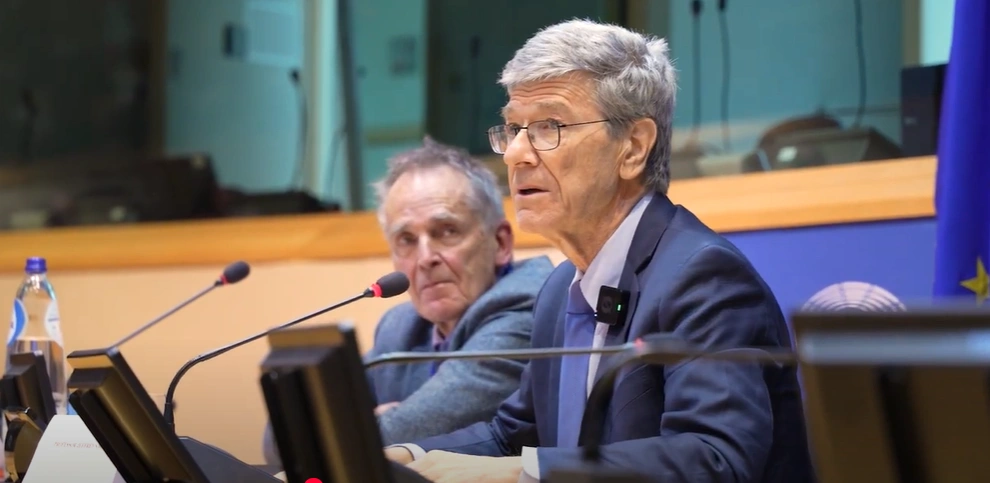 Jeffrey Sachs in the European Parliament
Jeffrey Sachs in the European Parliament
The Geopolitics of Peace
i. U.S. Foreign Policy
These are wars that the United States has led and caused. And this has been true for more than 30 years now. The United States came to the view, especially during 1990-91, and then with the end of the Soviet Union, that the US now runs the world, and that the US does not have to heed anybody’s views, red-lines, concerns, security viewpoints, international obligations, or any UN framework. I’m sorry to put it so plainly, but I do want you to understand.
I tried very hard in 1991 to get financial help for Gorbachev,(*2) who I think was the greatest statesman of our modern time. I recently read the archived memo of the National Security Council discussion of my proposal on June 3, 1991, reading for the first time how the White House completely dismissed it, and essentially laughed off the table my plea for the US to help the Soviet Union with financial stabilization and with financial aid to make its reforms. The memo documents that the US Government decided to do the very minimum to prevent disaster, but just the minimum.(*3) They decided that it’s not the US job to help. Quite the contrary.(*4)
When the Soviet Union ended in 1991, the view became even more exaggerated. And I can name chapter and verse, but the view was we [the US] run the show. Cheney, Wolfowitz, and many other names that you will have come to know literally believed this is now a US world, and we will do as we want. We will clean up from the former Soviet Union. We will take out any remaining Soviet-era allies. Countries like Iraq, Syria, and so forth will go. And we’ve been experiencing this foreign policy for now essentially 33 years. Europe has paid a heavy price for this because Europe has not had any foreign policy during this period that I can figure out. No voice, no unity, no clarity, no European interests, only American loyalty.
There were moments where there were disagreements and, I think, very wonderful disagreements. The last time of significance was 2003 in the lead-up to the Iraq war when France and Germany said we don’t support the United States going around the UN Security Council for this war. That war was directly concocted by Netanyahu and his colleagues in the US Pentagon.(*5) I’m not saying that it was a link or mutuality. I’m saying it was a war carried out for Israel. It was a war that Paul Wolfowitz and Douglas Feith coordinated with Netanyahu. And that was the last time that Europe had a voice. I spoke with European leaders then, and they were very clear, and it was quite wonderful to hear their opposition an unacceptable war. Europe lost its voice entirely after that, but especially in 2008. What happened after 1991, and to bring us to 2008, is that the United States decided that unipolarity meant that NATO would enlarge somewhere from Brussels to Vladivostok, step by step.
ii. NATO Expansion
There would be no end to eastward enlargement of NATO. This would be the US unipolar world. If you play the game of Risk as a child like I did, this is the US idea: to have the piece on every part of the board. Any place without a US military base is an enemy, basically. Neutrality is a dirty word in the US political lexicon.
Neutrality is perhaps the dirtiest word according to the US mindset. If you’re an enemy, we know you’re an enemy. If you are neutral, you are a subversive, because you’re really against us, but just not telling us. You’re only pretending to be neutral. So, this was indeed the mindset, and the decision was taken formally in 1994 when President Clinton signed off on NATO enlargement to the east.
You will recall that on February 7, 1990, Hans-Dietrich Genscher and James Baker III spoke with Gorbachev. Genscher gave a press conference afterwards where he explained that NATO will not move eastward.(*6) Germany and the US would not take advantage of the dissolution of the Warsaw Pact. Understand, please, that this commitment was made in a juridical and diplomatic context, not a casual context. These commitments were core to the negotiations to end World War II that made way for German reunification.
An understanding was reached that NATO will not move one inch eastward.(*7) And it was explicit, and it is in countless documents. And just look up National Security Archive of George Washington University, and you can get dozens of documents.(*8) It’s a website called “What Gorbachev Heard About NATO.” Take a look, please, because everything you’re told by the US about this promise is a lie, but the archives are perfectly clear.
So, the decision was taken by Clinton in 1994 to expand NATO all the way to Ukraine. This is a long-term US project. This is not due to one administration or another. This is a US government project that started more than 30 years ago. In 1997, Zbigniew Brzezinski wrote The Grand Chessboard, describing the NATO enlargement eastward.
That book is not just the musings of Mr. Brzezinski. That is his presentation to the public of decisions already made by the United States government, which is how a book like this works. The book describes the eastward enlargement of Europe and of NATO as simultaneous and conjoined events. And there’s a good chapter in that book that asks, what will Russia do as Europe and NATO expand eastward?
I knew Zbig Brzezinski personally. He was very nice to me. I was advising Poland, and he was a big help. He was also a smart man, and yet he got everything wrong in 1997. In 1997, he wrote in detail why Russia could do nothing but accede to the eastward expansion of NATO and Europe.(*9) In fact, he says the eastward expansion of Europe and not just Europe, but NATO. This was a US plan, a project. And Brzezinski explains how Russia will never align with China. Unthinkable. Russia will never align with Iran.
According to Brzezinski, Russia has no vocation other than the European vocation. So, as Europe moves east, there’s nothing Russia can do about it. So, says yet another American strategist. Is it any question why we’re in war all the time? Because one thing about America is we always “know” what our counterparts are going to do, and we always get it wrong! And one reason we always get it wrong is that in the non-cooperative game theory that the American strategists play, you don’t actually talk to the other side. You just know what the other side’s strategy is. That’s wonderful. It saves so much time. You simply don’t need any diplomacy.
iii. The Black Sea Strategy
So, this project began in earnest in 1994, and we have had a continuity of government policy for 30 years until maybe yesterday, perhaps.(*10) A thirty-year project. Ukraine and Georgia were the keys to the project. Why? Because America learned everything it knows from the British.
We are the wannabe British Empire. And what the British Empire understood in 1853, with Mr. Palmerston, excuse me, Lord Palmerston [together with Napoleon III], is that you surround Russia in the Black Sea, and you deny Russia access to the Eastern Mediterranean. What you’re watching is an American project to do the same in the 21st century. The US idea was that there would be Ukraine, Romania, Bulgaria, Turkey, and Georgia all in NATO, that would deprive Russia of any international status by blocking the Black Sea and essentially by neutralizing Russia as little more than a local power. Brzezinski is clear about this geography.
After Palmerston and before Brzezinski, there was of course Halford Mackinder in 1904: “Who rules East Europe commands the Heartland; Who rules the Heartland commands the World- Island; Who rules the World-Island commands the world.”(*11)
I’ve known the presidents and/or their teams. Nothing changed much from Clinton to Bush Jr. to Obama to Trump to Biden. Maybe they got worse step by step. Biden was the worst in my view. Maybe this is also because he was not compos mentis for the last couple of years. I say that seriously, not as a snarky remark. The American political system is a system of image. It’s a system of media manipulation every day. It is a PR system. You could have a president that basically doesn’t function and have that person in power for two years and run for reelection. The one thing is he had to stand on a stage for 90 minutes by himself, and that was the end of it. Had it not been that glitch, he would have gone on to have his candidacy, whether he was sleeping after 4 PM in the afternoon or not. So, this is the reality. Everybody goes along with it. It’s impolite to say what I’m saying because we don’t speak the truth about almost anything in this world right now.
So, this project went on since the 1990s. Bombing Belgrade 78 straight days in 1999 was part of this project. Splitting apart that country when borders are “sacrosanct,” aren’t they? Except for Kosovo, that is. Borders are sacrosanct except when America changes them. Breaking apart Sudan was another related US project. Consider the South Sudan rebellion. Did that just happen because South Sudanese rebelled? Or shall I give you the CIA playbook?
Let us please understand as grown-ups what this is about. Military campaigns are costly. They require equipment, training, base camps, intelligence, finance. That support comes from big powers. It doesn’t come from local insurrections. South Sudan did not defeat Sudan in a tribal battle. Breaking Sudan was a US project. I would go often to Nairobi and come across US military or Senators or others with a “deep interest” in Sudan’s internal politics. That war was part of the game of US unipolarity.
iv. U.S. Foreign Policy and NATO Expansion
And so, NATO enlargement, as you know, started in 1999 with Hungary, Poland, and the Czech Republic. Russia was extremely unhappy about it, but these were countries still far from Russia’s border. Russia protested, but, of course, to no avail. Then George Bush Jr. came into office. When 9/11 occurred, President Putin pledged all support to the US. And then the US decided around September 20, 2001, that it would launch seven wars in five years!
You can listen to General Wesley Clark on video speak about that.(*12) He was NATO’s Supreme Commander in 1999. He went to the Pentagon around September 20, 2001. He was handed a piece of paper explaining the prospect of seven US wars of choice. These were, in fact, Netanyahu’s wars.
The US Government plan was partly to clean up [remove] old Soviet allies and partly to take out supporters of Hamas and Hezbollah. Netanyahu’s idea was and is that there will be one state, thank you, in all pre-1948 Palestine. Yes, only one state. It will be Israel. Israel will control all the territory from the Jordan River to the Mediterranean Sea. And if anyone objects, we will overthrow them. Well, not Israel, exactly, but more specifically our friend, the United States. That’s been US policy until this morning. We don’t know whether it will change. Now the only wrinkle is that maybe the US will “own Gaza” [according to President Trump] instead of Israel owning Gaza.
Netanyahu’s idea has been around at least for 25 years. It goes back to a document called “Clean Break” that Netanyahu and his American political team put together in 1996 to end the idea of the two-state solution. You can also find that document online.(*13)
So, these are long-term US projects. It’s wrong to ask, “Is it Clinton? Is it Bush? Is it Obama?” That’s the boring way to look at American politics, as a day-to-day or year-to-year game. Yet that’s not what American politics is.
After 1999, the next round of NATO enlargement came in 2004 with seven more countries: the three Baltic states, Romania, Bulgaria, Slovenia, and Slovakia. At this point, Russia was pretty upset. This second-wave of NATO enlargement was a complete violation of the post-war order agreed at the time of German reunification. Essentially, it was a fundamental trick, or defection, of the US from a cooperative arrangement with Russia.
As everybody recalls, because we just had the Munich Security Conference last week, President Putin went to the MSC in 2007 to say, “Stop, enough is enough.” Of course, the US did not listen.(*14)
In 2008, the United States jammed down Europe’s throat it’s long-standing project to enlarge NATO to Ukraine and to Georgia. This is a long-term project. I listened to Mr. Saakashvili in New York City in the Spring of 2008, when he spoke at the Council on Foreign Relations. He told us that Georgia is in the heart of Europe and as such would join NATO. I walked out and called my wife, and said, “This man’s crazy; he’s going to blow up his country.” A month later, a war broke out between Russia and Georgia, in which Georgia was defeated. The most recent events in Tbilisi are again not helpful for Georgia, with your MEPs going there to prod protests. That doesn’t save Georgia; that gets Georgia destroyed, completely destroyed.
In 2008, as everybody knows, our former CIA director William Burns, who at the time was the US Ambassador to Russia, sent a long diplomatic cable back to Secretary of State Condoleezza Rice, which was famously entitled “Nyet means Nyet.”(*15) Burns’ message was that NATO enlargement was opposed by the entire Russian political class, not just President Putin.
We know about the cable only from Julian Assange. Believe me, not one word is told to the American people about anything of this by our government or our leading newspapers these days. So, we have Julian Assange to thank for the memo, which we can read in detail.
As you know, Viktor Yanukovych was elected as President of Ukraine in 2010 on the platform of Ukraine’s neutrality. Russia had no territorial interests or designs in Ukraine at all. I know. I was there off and on during these years. What Russia was negotiating during 2010 was a 25-year lease to 2042 for Sevastopol naval base. That’s it. There were no Russian demands for Crimea, or for the Donbas. Nothing like that at all. The idea that Putin is reconstructing the Russian empire is childish propaganda. Excuse me.
If anyone knows the day-to-day and year-to-year history, this is childish stuff. Yet childish stuff seems to work better than adult stuff. So, there were no territorial demands at all before the 2014 coup. Yet the United States decided that Yanukovych must be overthrown because he favored neutrality and opposed NATO enlargement. It’s called a regime change operation.
There have been around one hundred regime-change operations by the US since 1947, many in your countries [speaking to the MEPs] and many all over the world.(*16) That’s what the CIA does for a living. Please know it. It’s a very unusual kind of foreign policy. In the American Government, if you don’t like the other side, you don’t negotiate with them, you try to overthrow them, preferably, covertly. If it doesn’t work covertly, you do it overtly. You always say it’s not our fault. They’re the aggressor. They’re the other side.
They’re “Hitler.” That comes up every two or three years. Whether it’s Saddam Hussein, whether it’s Assad, whether it’s Putin, that’s very convenient. That’s the only foreign policy explanation the American people are ever given. Well, we’re facing Munich 1938. We can’t talk to the other side. They’re evil and implacable foes. That’s the only model of foreign policy we ever hear from our government and mass media. The mass media repeats it entirely because it’s completely suborned by the US government.
v. The Maidan Revolution and Its Aftermath
Now in 2014, the US worked actively to overthrow Yanukovych. Everybody knows the phone call intercepted by my Columbia University colleague, Victoria Nuland, and the US ambassador, Peter Pyatt. You don’t get better evidence. The Russians intercepted her call, and they put it on the Internet. Listen to it.(*17)
It’s fascinating. By doing that, they all got promoted in the Biden administration. That’s the job. When the Maidan occurred, I was called soon after. “Professor Sachs, the new Ukrainian prime minister would like to see you to talk about the economic crisis.” So, I flew to Kyiv, and I was walked around the Maidan. And I was told how the US paid the money for all the people around the Maidan, the “spontaneous” revolution of dignity.
Ladies and gentlemen, please, how did all those Ukrainian media outlets suddenly appear at the time of the Maidan? Where did all this organization come from? Where did all these buses come from? Where did all those people come from? Are you kidding? This is an organized effort. And it’s not a secret, except perhaps to citizens of Europe and the United States. Everyone else understands it quite clearly. Then after the coup came the Minsk agreements, especially Minsk II, which, incidentally, was modeled on South Tyrolean autonomy for the ethnic Germans in Italy. The Belgians too can relate to Minsk II very well, as it called for autonomy and language rights of the Russian speakers of Eastern Ukraine. Minsk II was supported unanimously by the UN Security Council.(*18) Yet the United States and Ukraine decided it would not be enforced. Germany and France, the guarantors of the Normandy process, also let it be ignored. This dismissal of Minsk II was another direct American unipolar action with Europe as usual playing a completely useless subsidiary role though it was guarantor of the agreement.
Trump won the 2016 election and then expanded arms shipments to Ukraine. There were many thousands of deaths in the shelling by Ukraine in the Donbas. There was no implementation of the Minsk II agreement. Then Biden came into office in 2021. I hoped for better but was profoundly disappointed once again. I used to be a member of the Democratic Party. I now am a member of no party because both are the same anyway. The Democrats became complete warmongers over time, and there was not one voice in the party calling for peace. Just as with most of your parliamentarians, the same way.
At the end of 2021, Putin put on the table a last effort to reach a modus operandi with the US, in two security agreement drafts, one with Europe and one with the United States. He put the Russia-US draft agreement on the table on December 15, 2021.
Following that, I had an hour-long call with [National Security Advisor] Jake Sullivan in the White House, begging, “Jake, avoid the war. You can avoid the war. All the US has to do is say, ‘NATO will not enlarge to Ukraine.’” And he said to me, “Oh, NATO’s not going to enlarge to Ukraine. Don’t worry about it.”
I said, “Jake, say it publicly.” “No. No. No. We can’t say it publicly.” I said, “Jake, you’re going to have a war over something that isn’t even going to happen?” He said, “Don’t worry, Jeff. There will be no war.” These are not very bright people. I’m telling you, if I can give you my honest view, they’re not very bright people. They talk to themselves. They don’t talk to anybody else. They play game theory. In noncooperative game theory, you don’t talk to the other side. You just make your strategy. This is the essence of non-cooperative game theory. It’s not negotiation theory. It’s not peacemaking theory. It is unilateral, noncooperative theory, if you know formal game theory.
That’s what they play. That kind of game theory started [in application] at the RAND Corporation. That’s what they still play. In 2019, there’s a paper by RAND, “Extending Russia: Competing from Advantageous Ground.”(*19) Incredibly, the paper, in the public domain, asks how the US should annoy, antagonize, and weaken Russia. That’s literally the strategy. We’re trying to provoke Russia, trying to make Russia break apart, perhaps have regime change, maybe unrest, maybe an economic crisis.
That’s what you in Europe call your ally. So, there I was with my frustrating phone call with Sullivan, standing out in the freezing cold. I happened to be trying to have a ski day. “Oh, there’ll be no war, Jeff.” We know what happened next: the Biden Administration refused to negotiate over NATO enlargement. The stupidest idea of NATO is the so-called open-door policy, based on Article Ten of the NATO Treaty (1949). NATO reserves the right to go where it wants, as long as the host government agrees, without any neighbor – such as Russia — having any say whatsoever.
Well, I tell the Mexicans and the Canadians, “Don’t try it.” You know, Trump may want to take over Canada. So, the Canadian Government could say to China, “Why don’t you build a military base in Ontario?” I wouldn’t advise it. The US would not say, “Well, it’s an open door. That’s Canada’s and China’s business, not ours.” The US would invade Canada.
Yet grownups, including in Europe, in this Parliament, in NATO, in the European Commission, repeat the absurd mantra that Russia has no say in NATO enlargement. This is nonsense stuff. This is not even baby geopolitics. This is just not thinking at all. So, the Ukraine War escalated in February 2022 when the Biden Administration refused any serious negotiations.
vi. The Ukraine War and Nuclear Arms Control
What was Putin’s intention in the war? I can tell you what his intention was. It was to force Zelensky to negotiate neutrality. This happened within days of the start of the invasion. You should understand this basic point, not the propaganda that’s written about the invasion claiming that Russia’s aim was to conquer Ukraine with a few tens of thousands of troops.
Come on, ladies and gentlemen. Please understand something basic. The idea of Russia’s invasion was to keep NATO out of Ukraine. And what is NATO, really? It is the US military, with its missiles, its CIA deployments, and all the rest. Russia’s goal was to keep the US away from its border. Why is Russia so interested in this? Consider if China or Russia decided to have a military base on the Rio Grande or in the Canadian border, not only would the United States freak out; we’d have war within about ten minutes. When the Soviet Union tried this in Cuba in 1962, the world nearly ended in nuclear Armageddon.
All of this is gravely amplified because the United States unilaterally abandoned the Anti- Ballistic Missile Treaty in 2002 and ended the relative stability nuclear arms control framework by doing so. This is extremely important to understand. The nuclear arms control framework is based, in large part, on trying to deter a first [decapitation] strike. The ABM Treaty was a critical component of that stability. The US unilaterally walked out of the ABM Treaty in 2002. This blew a Russian gasket. So, everything I’ve been describing about NATO enlargement has occurred in the context of the US destruction of the nuclear framework. Starting in 2010, the US began to put in Aegis anti-ballistic missile systems in Poland and then later in Romania. Russia doesn’t like that.
One of the issues on the table in December and January, December 2021, January 2022, was whether the United States claimed the right to put missile systems in Ukraine. According to former CIA analyst Ray McGovern, Blinken told Lavrov in January 2022 that the United States reserves the right to put missile systems in Ukraine.
That’s, my dear friends, is your putative ally. And now the US wants to put intermediate missile systems in Germany. Remember that the United States walked out of the INF treaty in 2019. There is no nuclear arms framework right now.(*20) Essentially, none.
When Zelensky said a few days after Russia’s invasion that Ukraine was ready for neutrality, a peace agreement was in reach. I know the details of this because I talked to key negotiators and mediators in detail and have learned much from public pronouncements of others. Shortly after the start of negotiations in March 2022, a document was exchanged between the parties that President Putin had approved, and that Lavrov had presented. This was being managed by the Turkish mediators. I flew to Ankara in the spring of 2022 to hear first-hand and in detail what happened in the mediation. The bottom-line is this: Ukraine walked away, unilaterally, from a near agreement.
vii. The End of the Ukraine War
Why did Ukraine walk away from the negotiations? Because the United States told them to and because the UK added icing to the cake by having BoJo [Boris Johnson] go to Kyiv in early April to Ukraine to make the same point. Keir Starmer turns out to be even worse, even more of a warmonger. It’s unimaginable, but it is true. Boris Johnson explained, and you can find it on the web, that what’s at stake here is nothing less than Western hegemony! Not Ukraine but Western hegemony. Michael von der Schulenberg and I met at the Vatican with a group of experts in Spring 2022, and we wrote a document explaining that nothing good can come out of continued war.(*21) Our group argued strenuously, but to no avail, that Ukraine should negotiate immediately, because delays will mean massive deaths, risk of nuclear escalation, and possibly an outright loss of the war.
I wouldn’t want to change one word from what we wrote then. Nothing was wrong in that document. Since the US talked Ukraine out of the negotiations, perhaps one million Ukrainians have died or been severely wounded. And American senators who are as nasty and cynical as imaginable say this is a wonderful expenditure of US money because no Americans are dying. It’s the pure proxy war. One of our senators nearby New York State, Connecticut’s Richard Blumenthal, said this out loud. Mitt Romney said this out loud. It’s the best money America can spend. No Americans are dying. It’s unreal.
Now, just to bring us up to yesterday, the US Ukraine Project has failed. The core idea of the project all along was that Russia would fold its hand. The core idea all along was Russia can’t resist, just as Zbigniew Brzezinski argued in 1997. The Americans thought the US surely has the upper hand.
The US will win because we’re going to bluff them. The Russians are not really going to fight. The Russians are really going to mobilize. We’ll deploy the economic “nuclear option” of cutting Russia out of SWIFT. That will destroy the economy. Our sanctions will bring Russia to their knees. The HIMARS will do them in. The ATACMS, the F-16s, will do them in. Honestly, I’ve listened to this kind of talk for more than 50 years. Our national security leaders have spoken nonsense for decades.
I begged the Ukrainians: stay neutral. Don’t listen to the Americans. I repeated to them the famous adage of Henry Kissinger, that to be an enemy of the United States is dangerous, but to be a friend is fatal. Let me repeat that for Europe: To be an enemy of the United States is dangerous, but to be a friend is fatal.
viii. The Trump Administration
Let me end with a few words about President Donald Trump. Trump does not want Biden’s losing hand. This is why Trump and President Putin are likely to agree to end the war. Even if Europe continues with its warmongering, it won’t matter. The war is ending. So, please, get it out of your system. Please tell your colleagues. “It’s over.” It’s over because Trump doesn’t want to hold on to a loser. The one that will be saved by the negotiations taking place right now is Ukraine. The second is Europe.
Your stock market is rising in recent days because of the “horrible news” of negotiations and potential peace. I know this prospect of a negotiated peace has been met with sheer horror in these chambers, but this is the best news that you could get. I’ve tried to reach out to some of the European leaders. I’ve said, don’t go to Kyiv, go to Moscow. Negotiate with your counterparts. You’re the European Union. You’re 450 million people and a $20 trillion economy. Act like it.
The European Union should be the main trading partner of Russia. Europe and Russia have complementary economies. The fit for mutually beneficial trade is very strong. By the way, if anyone would like to discuss how the US blew up Nord Stream, I’d be happy to talk about that too. The Trump administration is imperialist at heart. Trump obviously believes that the great powers dominate the world. The US will be ruthless and cynical, and yes, also vis-à-vis Europe. Don’t go begging to Washington. That won’t help. It would probably spur the ruthlessness. Instead, have a true European foreign policy.
So, I’m not saying that we’re at the new age of peace, but we are in a very different kind of politics right now, a return to great power politics. Europe needs its own foreign policy, and not just a foreign policy of Russophobia. Europe needs a foreign policy that is realistic, understands Russia’s situation, understands Europe’s situation, understands what America is and what it stands for, and that tries to avoid Europe being invaded by the United States. It’s certainly not impossible that Trump’s America will land troops in Greenland. I’m not joking, and I don’t think Trump is joking. Europe needs a foreign policy, a real one. Europe needs something different from, “Yes, we’ll bargain with Mr. Trump and meet him halfway.” Do you know what that will be like? Give me a call afterwards.
Please have a European foreign policy. You’re going to be living with Russia for a long time, so please negotiate with Russia. There are real security issues on the table both for Europe and Russia, but the bombast and the Russophobia is not serving your security at all. It’s not serving Ukraine’s security at all. This American adventure that you signed on to and for which you are now the lead cheerleader has contributed to around 1 million Ukrainian casualties.
ix. On the Middle East and China
On the Middle East, incidentally, the US completely handed over foreign policy to Netanyahu 30 years ago. The Israel lobby dominates American politics. Please, have no doubt about it. I could explain for hours how it works. It’s very dangerous. I’m hoping that Trump will not destroy his administration, and far worse, the Palestinian people, because of Netanyahu, whom I regard as a war criminal who has been properly indicted by the ICC.(*22)
The only way for Europe to have peace on your borders with the Middle East is the two-state solution. There is only one obstacle to it, and that is the veto of the United States in the UN Security Council, at the behest of the Israel Lobby. So, if you want the EU to have some influence, tell the United States to drop the veto. In this the European Union would be together with around 160 other countries in the world. The only ones that oppose a Palestinian state are basically the United States, Israel, Micronesia, Nauru, Palau, Papua New Guinea, Argentina, and Paraguay.(*23)
The Middle East is a place where the European Union could have a big geopolitical influence. Yet, Europe has gone silent about the JCPOA and Iran and around half of Europe has gone silent over Israel’s war crimes and blockage of the two-state solution.
Netanyahu’s greatest dream in life is the war between the United States and Iran. And he’s not given up. It’s not impossible that a US-Iran War will also come. Yet Europe could stop it – if Europe has its own foreign policy. I’m hoping that Trump will end Netanyahu’s grip on American politics. Even if not, the EU can work with the rest of the world to bring peace to the Middle East.
Finally, let me just say with respect to China, China is not an enemy. China is merely a great success story. That’s why it is viewed by the United States as an enemy, because China has a bigger economy than the United States (measured in international prices). The US resists reality. Europe should not do so. Let me repeat, China is no enemy and no threat. It is a natural partner with Europe in trade and in saving the global environment.
That’s all. Many thanks.
The post Jeffrey Sachs Blasts US-EU on Russia-Ukraine Issue first appeared on China Academy.
]]>The post Time for Europe to Do the Unthinkable first appeared on China Academy.
]]>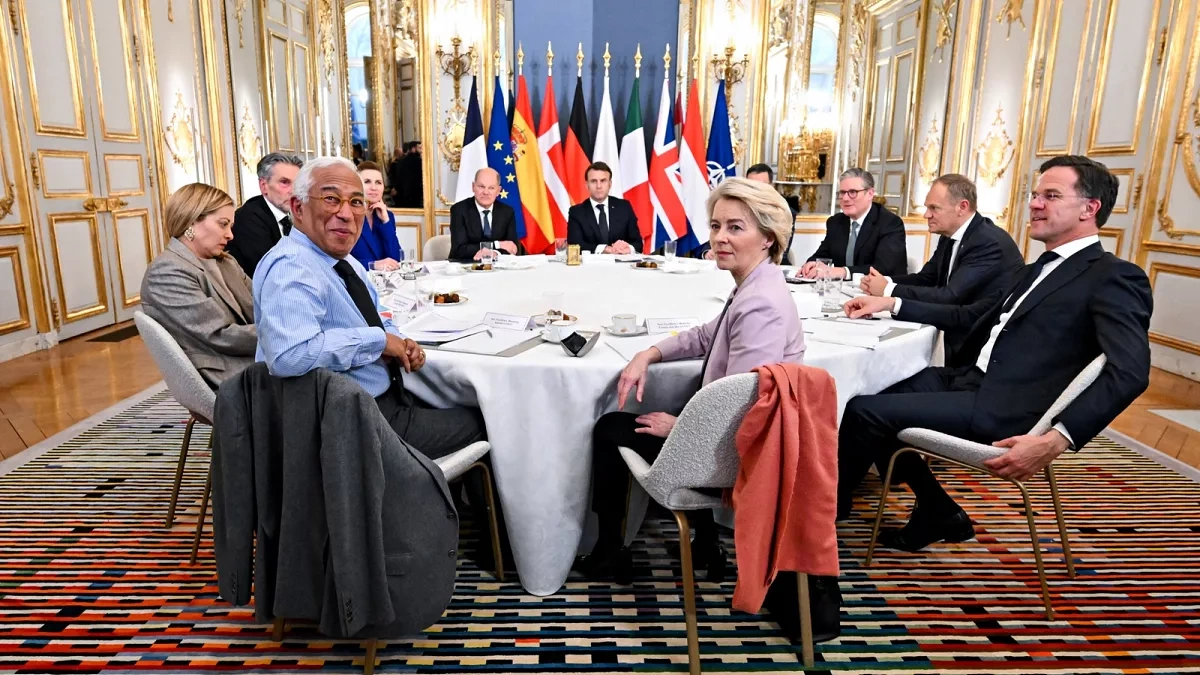 On February 17, European leaders held an emergency meeting in Paris to discuss how to respond to the negotiations between the U.S. and Russian delegations in Saudi Arabia.
On February 17, European leaders held an emergency meeting in Paris to discuss how to respond to the negotiations between the U.S. and Russian delegations in Saudi Arabia.
Desperate times call for desperate measures. And as my geopolitical gurus taught me, one must always think the unthinkable, as Europe must do now.
It’s too early to tell who the real winners and losers from the second Trump administration will be. Things could change. Yet, there’s no doubt that Europe’s geopolitical standing has diminished considerably. U.S. President Donald Trump’s decision to not even consult with or forewarn European leaders before speaking to Russian President Vladimir Putin shows how irrelevant Europe has become, even when its geopolitical interests are at stake. The only way to restore Europe’s geopolitical standing is to consider three unthinkable options.
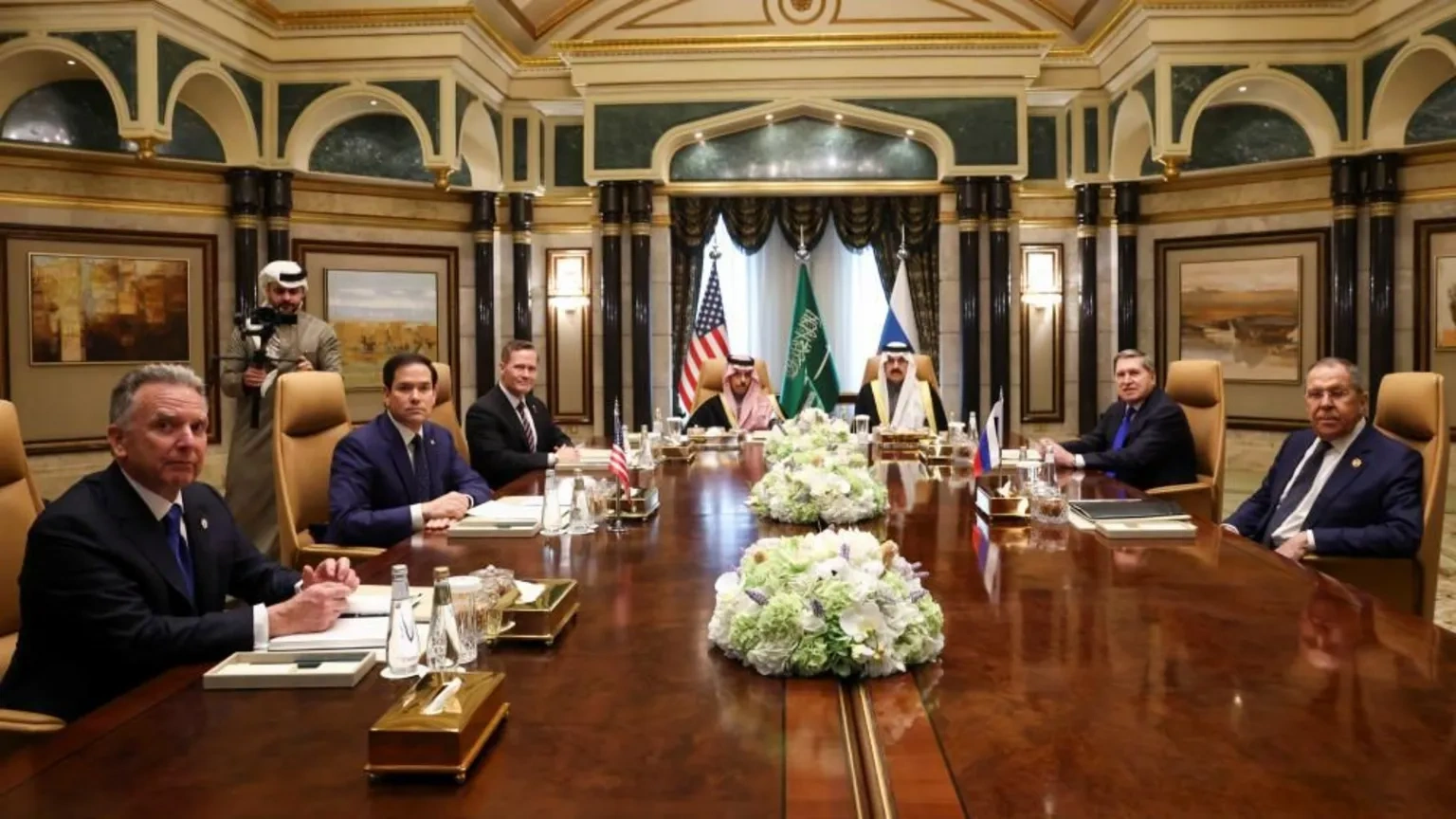 On February 18, the foreign ministers of the U.S. and Russia held a meeting in Saudi Arabia.
On February 18, the foreign ministers of the U.S. and Russia held a meeting in Saudi Arabia.
First, Europe should announce its willingness to quit NATO. A Europe that is forced to spend 5 percent on defense is a Europe that doesn’t need the United States. Five percent of the combined EU/U.K. GDP in 2024 amounts to $1.1 trillion, comparable to U.S. defense spending of $824 billion in 2024 (In 2024, the EU and U.K. combined spent around $410 billion on defense.). Eventually, Europe need not quit. But only a credible threat to leave would wake up Trump (and Vice President J.D. Vance and Defense Secretary Pete Hegseth) and force him to treat Europe with respect. By contrast, the insistence of the Europeans on staying in NATO after Trump’s provocative actions gives the impression to the world that they are licking the boots that are kicking them in the face.
What shocks many in the world is that Europeans didn’t anticipate the quagmire they’re in. One of the first rules of geopolitics is that we must always plan against worst-case scenarios. After the Ukraine war broke out, all European strategic thinking was based on the best-case scenario of the United States being a totally reliable ally, despite having experienced Trump’s first term and his threats to pull out of the world’s biggest military alliance. For a continent that has produced strategic minds like Metternich, Talleyrand, and Kissinger, there has been almost infantile strategic thinking on Ukraine and its long-term consequences.
If Metternich or Talleyrand (or Charles de Gaulle) were alive today, they would recommend unthinkable option 2: Work out a new grand strategic bargain with Russia, with each side accommodating the other’s core interests. Many influential European strategic minds would balk at these suggestions, because they are convinced that Russia represents a real security threat to the EU countries. Really? Which is Russia’s most fundamental strategic rival, the EU or China? With whom does it have the longest border? And with whom has its relative power changed so much? The Russians are geopolitical realists of the highest order. They know that neither Napoleon’s troops nor Hitler’s tanks are going to advance to Moscow again. The Europeans don’t see the obvious contradiction between exulting in Russia’s inability to defeat Ukraine (a country of 38 million people and a GDP of about $189 billion in 2024) and then declaring that Russia is the real threat to Europe (which has 744 million people and a GDP of $27 trillion in 2024). The Russians would likely be happy to work out a fair compromise with the EU, respecting current borders between Russia and the EU and a realistic compromise on Ukraine that doesn’t threaten either side’s core interests.
In the long run, after some strategic trust has redeveloped between Russia and a new strategically autonomous Europe, Ukraine could gradually serve as a bridge between the EU and Russia rather than as a bone of contention. Brussels should consider itself fortunate that, in relative terms, Russia is a declining power, not a rising power. If the Association of Southeast Asian Nations, a relatively weaker regional organization, can work out a long-term relationship of trust with a rising power like China, surely the EU can do better with Russia.
And this leads to unthinkable option 3: Work out a new strategic compact with China. Again, in the realm of the ABCs of foreign policy, there’s an important reason why geopolitics is a combination of two words: geography and politics. The geography of the United States, which faces China across the Pacific Ocean, combined with Washington’s urge for primacy, explains the hostile relationship between the United States and China. What geopolitical pressures have caused the downturn in EU-China relations? The Europeans foolishly believed that a slavish loyalty to American geopolitical priorities would lead to rich geopolitical dividends for them. Instead, they have been kicked in the face.
The remarkable thing here is that China can help the EU deal with its real long-term geopolitical nightmare: the demographic explosion in Africa. In 1950, Europe’s population was double that of Africa. Today, Africa’s population is twice as large as Europe’s. By 2100, it will be 6 times larger. Unless Africa develops its economies, there will be a surge of African migrants into Europe. If Europeans believe that Europe will never produce leaders like Trump, they are clearly being delusional. Elon Musk isn’t the only billionaire supporting far-right parties in Europe.
To preserve a Europe run by centrist parties, Europeans should welcome any foreign investment in Africa that creates jobs and keeps Africans at home. Instead, the Europeans are shooting themselves in the foot by criticizing and opposing China’s investment in Africa. Just this one act demonstrates how naive long-term European strategic thinking has become. Brussels is sacrificing its own strategic interests to serve American interests in the hope that geopolitical subservience would lead to rewards.
Clearly, it hasn’t. Two thousand years of geopolitics has taught us a simple and obvious lesson: All great powers will put their own interests first and, if necessary, sacrifice the interests of their allies. Trump is behaving like a rational geopolitical actor in putting what he perceives to be his country’s interests first. Europe shouldn’t just criticize Trump—instead, it should emulate him. It should carry out the currently unthinkable option: Declare that henceforth it will be a strategically autonomous actor on the world stage that will put its own interests first. Trump may finally show some respect for Europe if it does that.
The post Time for Europe to Do the Unthinkable first appeared on China Academy.
]]>The post After Putin Call, Trump Declares Russia has Won the Ukraine War first appeared on China Academy.
]]>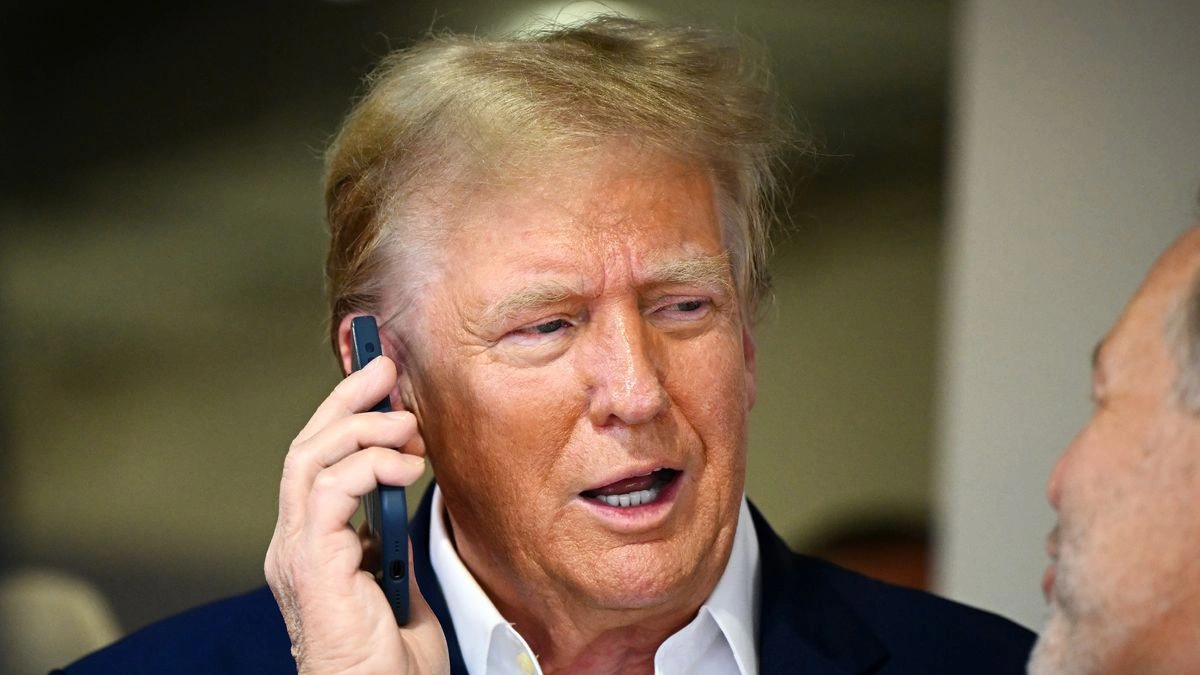
On February 12, Putin and Trump had a phone conversation. After that, two public statements from the Trump administration indicated that the U.S. had effectively submitted a surrender letter to Russia, on behalf of Ukraine and Europe.
First, the initial objective of Russia’s special military operation was to stop Ukraine from joining NATO. On February 14, The New York Times reported that Trump had clearly stated that NATO would not accept Ukraine. Zelensky, in his speech at the 2025 Munich Security Conference (MSC), also admitted that the U.S. had never supported Ukraine’s NATO membership. This means Russia has fully achieved its strategic goal of halting NATO expansion, securing a de facto victory.
Second, as the Russia-Ukraine conflict developed, Russia set a new war objective: to turn four eastern Ukrainian provinces into its territory. On the same day as Trump’s phone call with Putin, U.S. Defense Secretary Pete Hegseth called a return to Ukraine’s pre-2014 borders “an unrealistic objective” and an “illusionary goal.” This statement signified that the U.S. had, in effect, “ceded” Ukrainian territory, acknowledging that Russia had met its additional war objectives.
That day, Trump and Putin talked for over 90 minutes. Compared to the three-year-long Ukraine War, this phone call was brief. But for Ukraine and Europe, it felt like an eternity because it was clear that in this conversation between old friends, they were no longer just listeners at the table—they had already been printed on the menu.
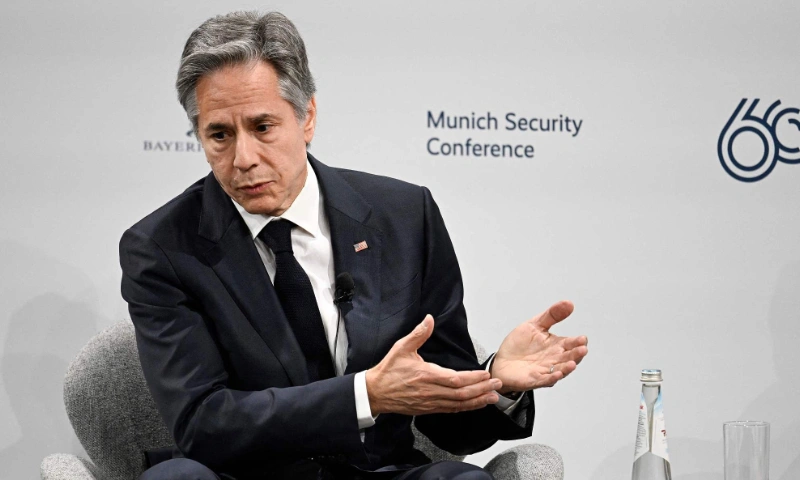 US Secretary of State Antony Blinken, when he took part in a panel discussion at the 2024 Munich Security Conference, said, ‘If you’re not at the table in the international system, you’re going to be on the menu.’
US Secretary of State Antony Blinken, when he took part in a panel discussion at the 2024 Munich Security Conference, said, ‘If you’re not at the table in the international system, you’re going to be on the menu.’
When Trump devoured Europe and Ukraine, he didn’t even allow them to cry out. This year’s MSC was supposed to focus on two main issues: how to end the war in Ukraine without capitulating to Russia, and how Europe could increase its defense spending. However, U.S. Vice President JD Vance, attending the conference, did not discuss these topics. Instead, he launched a harsh critique of European allies, including the UK.
Vance pointed out that Europe’s biggest threat was not Russia or China, but internal dangers. He criticized the European elite class for using the judicial system to suppress free speech, overthrowing Romania’s election results with unreliable intelligence, and deliberately ignoring public concerns about illegal immigration. During those 20 minutes, Europe remained silent.
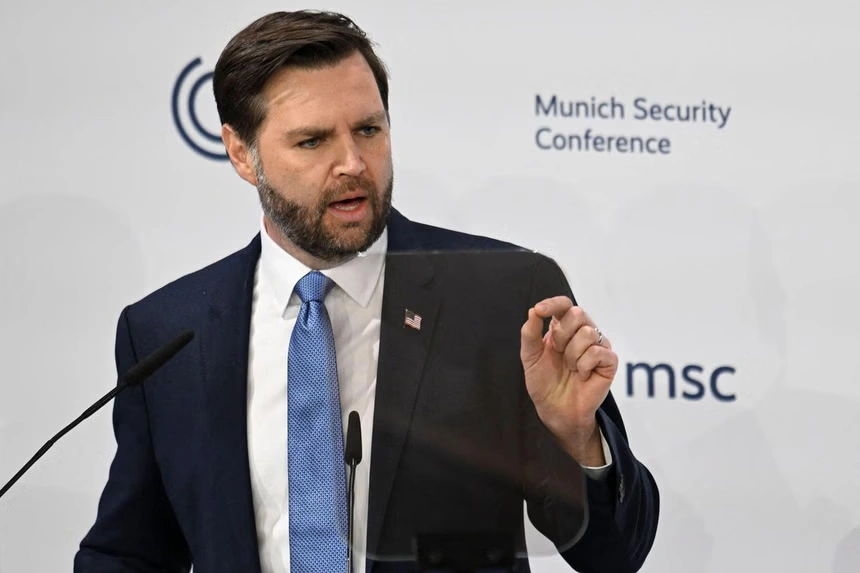 US Vice-President J.D. Vance delivering his speech during the 61st Munich Security Conference on Feb 14.
US Vice-President J.D. Vance delivering his speech during the 61st Munich Security Conference on Feb 14.
This outspokenness was not tolerated by “tolerant” Europeans, the Guardian later commented, “the moment the world order against which Putin railed fell apart.”
But what The Guardian didn’t dare admit was that the “world order” Europe maintained was a complete mistake. Within this, two glaring misconceptions persist that Europe cannot seem to escape.
Europe’s first misconception is underestimating Russia.
Before the Ukraine War broke out, the U.S. and Europe tried to dismember Russia again through economic sanctions, color revolutions, and military pressure. These strategies were effective against small and medium-sized countries like Yugoslavia. However, they overlooked one point: Russia is not a “small or medium-sized country.”
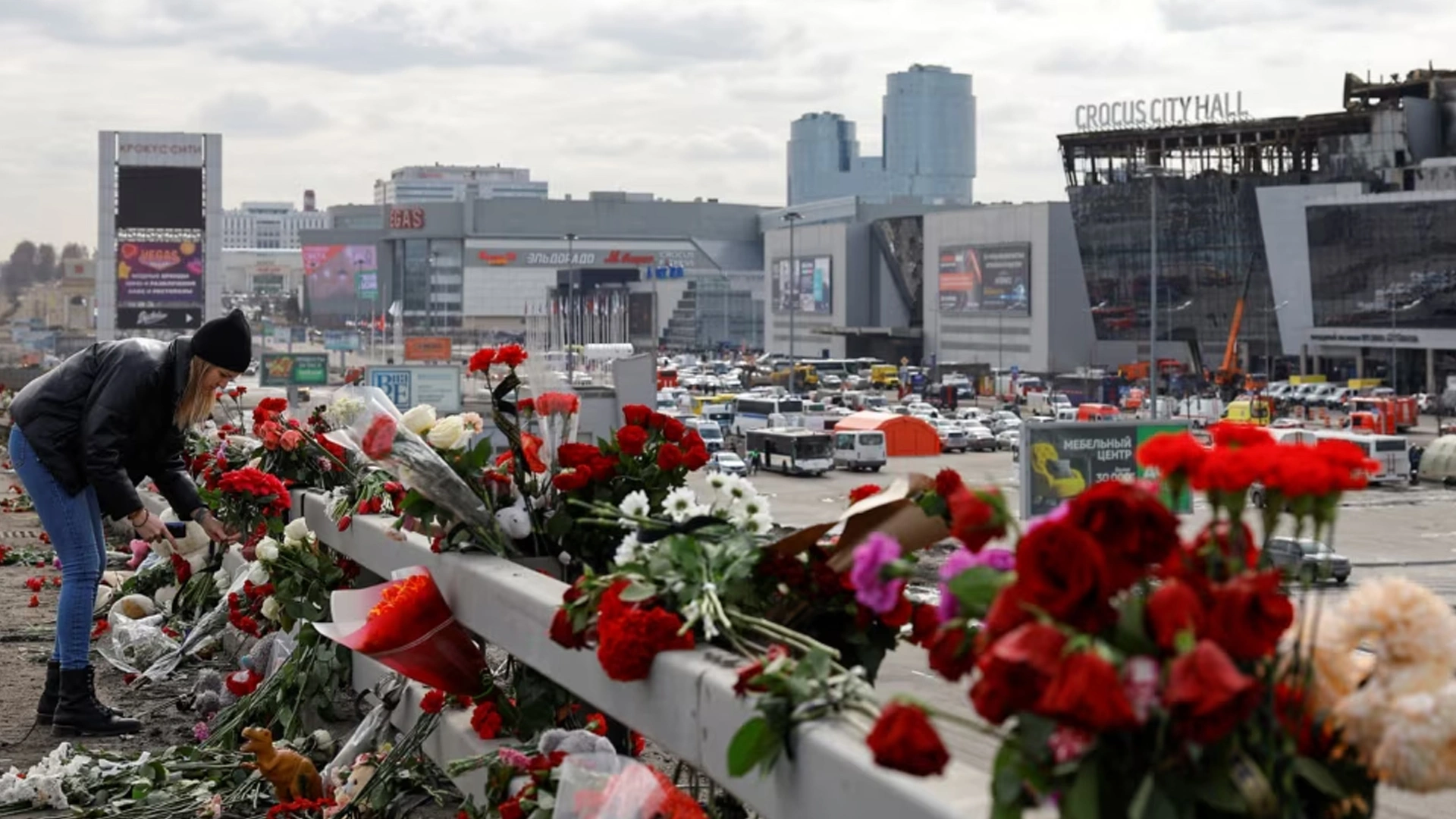 A Russian lady lays flowers on the roadside in front of the burned-out Crocus City Hall following a deadly attack at the concert venue that left 140 people dead.
A Russian lady lays flowers on the roadside in front of the burned-out Crocus City Hall following a deadly attack at the concert venue that left 140 people dead.
Trump’s insight over Europe and previous U.S. administrations was that for a country inheriting the Soviet nuclear arsenal and much of its military power, pushing it into a corner would backfire. Therefore, to bring Russia back to the negotiating table, it had to be given the respect its power warranted. For example, during the call, Trump even suggested inviting Russia back into the G8. This indicated that, in the eyes of the U.S., Russia was no longer just leftovers from the Soviet Union but had returned to the table as one of the main guests.
This realism might appear as the collapse of the “world order” to some politically naive European countries. But only nuclear powers like the U.S., Russia and China can truly understand that to destroy an opponent, the entire world risks destruction. Trump’s sacrifice of Europe’s imagined world order was in fact to preserve the real, albeit imperfect, world.
Europe’s second misconception is underestimating itself.
Europe was not initially kicked off the table by the U.S.; rather, it voluntarily crawled under the table out of intellectual shortsightedness or laziness, leading to its current predicament.
NATO has always been a tool used by the U.S. to contain the Soviet Union and Russia under a bipolar system. Europe once lived in the shadow of the Red Giant and had to become part of this encirclement. The Cold War propaganda focused on interests, causing Europeans to overlook the costs. It seemed as though aligning with the U.S. would bring safety and prosperity forever. This mentality still exists today, even after the Soviet Union’s collapse.
For instance, when the U.S. proposed sanctions on Russia and aid to Ukraine, many terms clearly contradicted Europe’s interests—such as abandoning stable, cheap Russian gas pipelines in favor of expensive U.S. liquefied natural gas—but still, they were loyally implemented.
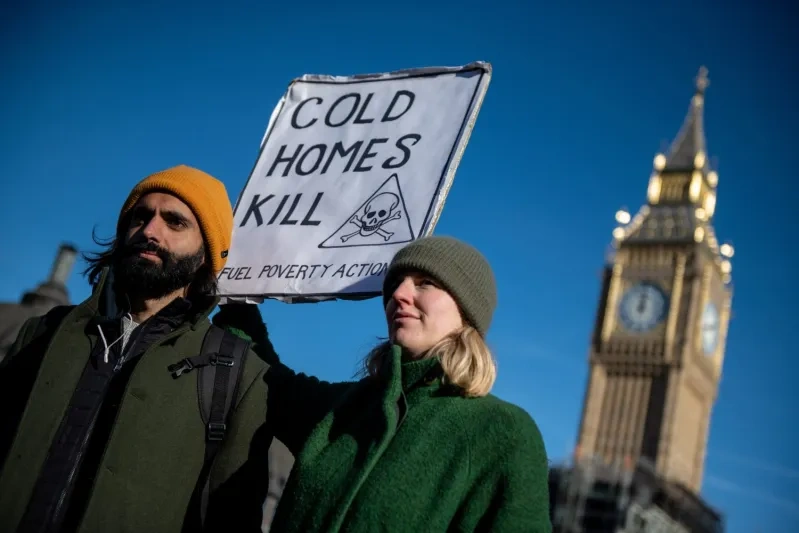 Protesters attend a demonstration against rising energy prices on Parliament Square in London, 2022
Protesters attend a demonstration against rising energy prices on Parliament Square in London, 2022
Though today’s Europeans excel at reflecting on their colonial history, they seem to have forgotten that when a government does not represent its people’s interests and merely obeys another government, we call it a vassal state or a puppet.
This economic and security blind obedience is Europe’s self-exile and the most incoherent part of the world order they imagine. European countries like to tout slogans of equality and freedom, but when developing policies on Russia, they fail to position themselves as sovereign states equal to the US, making independent decisions. JD Vance merely exposed their contradictory illusions, yet The Guardian now criticizes him for causing the collapse of their world order. This dullness is truly regrettable.
In conclusion, for China, the U.S. taking the initiative to ease relations with Russia is a positive signal. This means some Western policymakers are starting to reassess problems from a practical standpoint. Today, China is also a pole that can never be eliminated. If the U.S. continues this pragmatic and materialist approach to reconsidering China-U.S. issues, both countries and the world will enjoy more substantial and stable development.
As for Europe and Ukraine, there are two moments when they should wake up from their collective illusions: one is the past, and the other is now. Perhaps Europeans should consider awarding President Trump a Nobel Peace Prize because he is about to effectively end a war that has lasted for almost 3 years in Europe.
The post After Putin Call, Trump Declares Russia has Won the Ukraine War first appeared on China Academy.
]]>The post Trump Caught the EU Off Guard first appeared on China Academy.
]]>The post Trump Caught the EU Off Guard first appeared on China Academy.
]]>The post China’s Ukraine Peace Plan: A Solution from Day One first appeared on China Academy.
]]>Regardless, China’s “principled neutrality” has played a crucial role in preventing the conflict from spilling beyond Europe and even spiraling into a nuclear confrontation towards World War III.
Beyond China’s vast economic power and military potential, the key to this stabilizing influence lies in its “principled” and “impartial” neutrality. Unlike the “pure,” “permanent,” or passive neutrality seen in European history (e.g., Switzerland), China does have its opinion and preference regarding the nature of the Ukraine war, particularly its origin, which is NATO expansion.
The East: NATO’s Fatal Attraction
From the beginning, Russia’s “special military operation” in Ukraine has been framed in the Anglosphere as an “unprovoked attack.” From China’s perspective, however, Russia’s use of force was the inevitable consequence of NATO’s relentless eastward expansion. Since the end of the Cold War, there have been five waves of such expansions to the east despite strong warnings from Moscow.
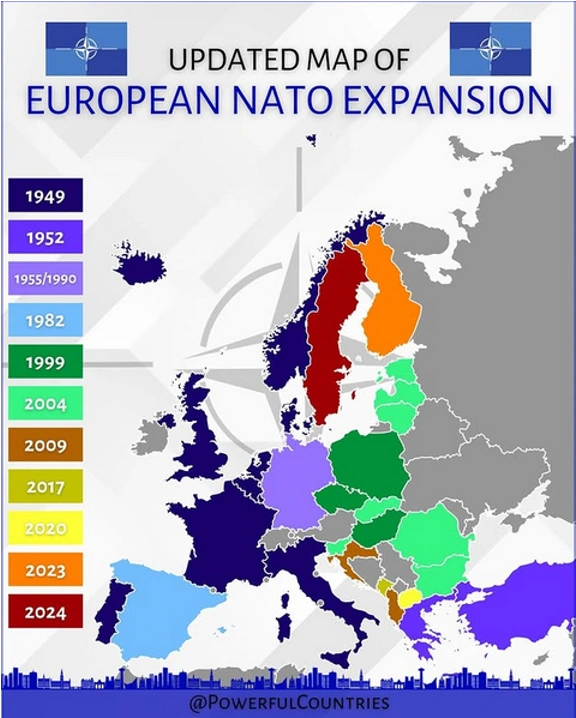
China is not alone in this assessment. In 1997, George Kennan, the chief architect of America’s Cold War containment strategy, warned that NATO expansion “would be the most fateful error of American policy in the entire post-Cold War era.” Former U.S. Ambassador to the Soviet Union Jack Matlock echoed Kennan’s concerns, calling the expansion a “misguided” decision that “may well go down in history as the most profound strategic blunder….” Bill Clinton’s Secretary of Defense William Perry went as far as to resign because he disagreed with Clinton’s “rosier scenario” about NATO expansion. Henry Kissinger, too, cautioned that Ukraine’s survival and thriving must be based on its neutrality as a “bridge,” not a battlefield, between Russia and the West.

Despite these sober warnings from some of the West’s most seasoned strategists, their insights were largely dismissed by the liberal interventionists and neoconservatives who shaped post-Cold War foreign policy. The world now is living with the blowback of the West’s arrogance and ignorance.
China’s “Constructive” Neutrality: Pragmatism, Humanitarianism, and Political Realism
Maintaining a neutral and impartial stance on the Ukraine war in a deeply divided world is no easy task. Yet China chose the hard way. Its position rests on several core principles: upholding the UN’s commitment to sovereignty and territorial integrity, supporting all efforts toward a peaceful resolution of the crisis, and advocating for common, comprehensive, and sustainable security for all, not just a few. China has also consistently emphasized the need to protect civilian lives and property, reframed from providing weapons to the warring parties, and urged restraint to prevent further escalation.
China’s neutrality in the Ukraine conflict, therefore, is not passive or indifferent but rather a blend of pragmatism, humanitarianism, and political realism. Unlike the European tradition of neutrality as an end in itself or neutrality for neutrality’s sake, China’s approach is one of “constructive engagement,” as described by Zhao Huasheng, a prominent Russologist at Fudan University in Shanghai. Reflecting this commitment, China’s special envoy for Eurasian affairs, Li Hui, conducted four rounds of shuttle diplomacy between May 2023 and July 2024 (May 2023; March, May, and July 2004), seeking a political resolution to the ongoing conflict.
Normal Relationship in Abnormal Times
China’s principled neutrality in the Ukraine war is grounded in its “normal ties”—or balanced and stable relations—with both Ukraine and Russia. At a minimum, both Russia and Ukraine are China’s friends. It is immoral, or amoral, for China to support one at the expense of the other.
For years, Ukraine has been a vital economic partner for China. Until 2022, Ukraine served as the most significant hub for China’s expansive Belt and Road Initiative (BRI) in Central and Eastern Europe. Beyond this, Ukraine also played a critical role in China’s military modernization in the post-Cold War era.
At the height of the 2013 Crimea crisis, China extended an unprecedented $8-billion economic package to Ukraine—the largest offer from outside Europe. An indicator of this normal, and strong partnership with China is Ukraine’s continuous hold on its one-China policy, despite increasing Western support for Taiwan’s independence. During his visit to China in May 2024, Ukraine’s then-FM Kuleba went as far as to say, “China is a great country, and Ukraine and China are not only strategic partners but also important economic and trade partners.”
In the case of China-Russia relations, the West often portrays China as Russia’s “chief enabler” in the Ukraine war. But such a characterization distorts the nature of the China-Russia relationship.

The current Sino-Russian “comprehensive strategic partnership” is essentially a normal relationship after the 10-year Sino-Soviet alliance between 1949 and 1959 and 30-year adversarial relations from 1960 to 1989. A key element of this normal relationship is the absence of ideology, which exaggerated, unnecessarily, the “love-hate” oscillation between 1949 and 1989. Now the two sides treat each other as who they are rather than what they wish to see each other.
In the strategic domain, the China-Russian partnership is not an alliance because it does not have an interlocking mechanism similar to NATO’s “Article 5” that automatically commits one side to the other in times of war. Instead, this normalcy provides two large powers with freedom of action and strategic depth after the “best” and “worst” times in the past.
While China and Russia’s relationship is not without challenges, their differences are usually managed through dialogue and compromise, rather than being politicized. Largely because of this, the current partnership relationship is perhaps the most equal, most stable, and least harmful form of interaction between the two powers. This is very different from much of the 19th and 20th centuries when Russia forcefully inserted itself into a weak and chaotic China by either Czarist imperialism or by Bolshevik’s revolutionary idealism and Stalin’s brutal realism.
Tales of Russia’s Two Borders
A cornerstone of such a normal and stable relationship between Moscow and Beijing is the final resolution of the centuries-long border issue—a stark contrast to Russia’s unsettling and conflict-ridden western borders.
Both Gorbachev and Yeltsin began their presidencies with sweeping pro-Western policies. The initial enthusiasm of Gorbamania and Yeltsin’s “shock therapy,” however, quickly soured into a state of “cold peace.” This deterioration was largely driven by NATO’s relentless eastward expansion, despite earlier Western assurances of “not one inch” moving eastward. As a result, Russia’s “not-so-quiet” western front has remained volatile, ultimately culminating in the largest and most intense conventional war in Europe since World War II with the potential of escalating into World War III, or even nuclear conflict.
In contrast to its romantic and often tragic interactions with the West in the post-Soviet decades, Russia’s relationship with its eastern neighbor, China, has been far more pragmatic and uneventful. It took 22 years (1982–2004) for both sides to fully normalize relations and reach a settlement on the border issues. A major step in this process was the formation of the Shanghai-Five (China, Russia, Kazakhstan, Kyrgyzstan, and Tajikistan) in 1996, which institutionalized demilitarization, confidence-building measures, border demarcation, and long-term stability. The once most heavily militarized frontiers of the Cold War are now a zone of stability and thriving cross-border trade, cultural exchange, and social interaction.
The current strategic partnership relations between China and Russia, therefore, have strong internal dynamics, and institutionalized channels of communication and management. Both sides benefited enormously from this normalcy in bilateral interactions.
Had the West pursued a similar pragmatic approach with Russia regarding border disputes, as China did, the devastating loss of hundreds of thousands of Ukrainian and Russian lives might have been averted.
“The Ukrainian conflict should never have happened, and would not have happened if I were President… But as I have made very clear for quite some time, this could now end up being World War III,” declared presidential candidate Donald Trump back in September 2022. In the 28 months leading up to his second presidency (Jan. 20, 2025), tens of thousands more Ukrainians and Russians perished in the largest conventional war in Europe since World War II.

While US President Donald Trump is rushing to undo his predecessor’s war, China remains steadfast in its posture of principled neutrality not just for ending the bloody war but is poised to shape the postwar settlement into a more just and durable peace in Europe and beyond.
The post China’s Ukraine Peace Plan: A Solution from Day One first appeared on China Academy.
]]>The post A Brave & Grave New World of Trump 2.0? first appeared on China Academy.
]]>Two Trumpian Presidencies: Domestic Constraints vs. Foreign Policy Surprises?
Such a sense of uncertainty is the result of two outcomes of the 2024 election. On the one hand, Trump possesses unprecedented political prowess, and even a mandate, from his electoral victory over his Democrat opponent Biden.
The Republicans also gained control over the legislative and judiciary branches of the government. This fusion of power, which frequently happens in parliamentary democracy, is rarely seen in the U.S. On top of all of this is Trump’s exceptional charisma and persuading power among his supporters, or 50% of Americans.
On the other hand, Trump’s domestic agenda (MAGA, etc.) is facing a lot of hurdles and opposition, such as the perception of a “deep state”, real or perceived; a deeply divided elite; and a dysfunctional, and highly politicized, civil service (such as during the LA fire). This is what Samuel Huntington defined in 1968 (Political Order and Political Decay), and later Francis Fukuyama in 2014 (Political Order and Political Decay: From the Industrial Revolution to the Globalization of Democracy) called “political decay.”

Last if not least, the US society is plagued by inflation, violent crimes, a culture of gun-related violence, random or politically motivated, too many drugs, a growing homeless population (almost 800,000), an increasingly unaffordable healthcare system, etc.
Given these domestic hurdles, foreign policy is perhaps an area where President Trump could achieve some quick and visible gains. This was why Trump, in his inauguration speech, focused on domestic challenges, while giving only lip service to foreign policy issues.
Historically, and particularly after WWII, there has been an increasing concentration of presidential power over foreign policy. This is the phenomenon of the so-called “two presidencies” in the U.S.: a constrained president on domestic issues, and a president who reigns supreme in foreign affairs. And the Trump presidency is no exception.
“Three Strikes” of Trump’s Foreign Policy
His foreign policy priority can be summarized as the “Three Ts”: tariff or trade wars against all; territorial acquisition (Greenland, Canada, Panama Cannel, etc.); and terminating, or ending, the Ukraine War.
There is, however, always a gap between the highly rhetorical and moralistic campaign promises, and actual policies once the president is in office. It remains to be seen to what extent candidate Trump’s “three strikes,” or “three Ts,” can be played out in his first 100 days (or, in Chinese, it is called 新官上任三把火).
Each of these three issues is a league of its own, and there are limits how much Trump can achieve these goals. Tariffs, for example, may generate some quick pocket money, but not without pain. It will add pressure to the already high inflation. Moreover, it may not lead to eventual import substitution. This is because the U.S. lacks engineers and skilled workers and it takes decades to train them.
In fact, the US manufacturing sector has continued to decline in the past decade despite increasing Federal subsidies. Just look at the cases of Boeing, Intel, US Steel, etc. Even the US military finds itself highly dependent on China’s supply chains according to some recent Pentagon estimates. Moreover, new investments are more likely to use automation and AI, rather than hiring more expensive workers. Last if not least, the US manufacturing sector, which is about only 10% of the GDP, is particularly vulnerable to retaliations from other countries. President Trump, therefore, will have to navigate carefully in a trade war, which usually produces losers.

The second T is about territorial acquisition. As presidential candidate and president-elect, Trump repeatedly voiced his desire for land acquisition regarding Greenland, Canada, and Panama Canal. Given the huge power disparities between the US and these smaller and weaker states, the US does have the power to prevail. The question is whether the US has the authority, or the legitimacy, to take land from others in such a forceful manner. Even back in 1900, Teddy Roosevelt preferred “speaking softly” while carrying a “big stick.”

The Trump team, therefore, will have to choose between “leading” (Americans love to talk about leading the world) by example of power, which was prevalent in times of colonialism and imperialism, or leading by the power of example of being a more benevolent hegemony able to persuade others with meaningful diplomacy. Of course, Trump’s articulated desire for land acquisition may be a kind of high-pressure negotiating tactic. Real policies could be more prudent. I hope so.

The third T is how to terminate, or end, the Ukraine war. On the campaign trail, Trump promised many times to that he would end the war in 24 hours. Ending the war, or any war, could be far more difficult than starting one, according to Henry Kissinger’s 2014 op-ed in the Washington Post on the Crimea crisis. For him, “[T]he test of policy is how it ends, not how it begins.”
Regardless, ending the bloody war in Ukraine is now on the agenda. For Trump, the Ukraine war was caused by NATO expansion. This is very similar to George Kennan’s 1997 warning in the New York Times that NATO expansion “would be the most fateful error of American policy in the entire post-cold-war era.”

Unfortunately, Kennan’s warning was ignored by the post-Cold War liberal interventionists and neocons. Five rounds of NATO eastward expansion eventually led to the Ukraine War and the death of tens of thousands of Ukrainians and Russians.
For China, and perhaps for most people in the Global South, letting others die for one’s own interests, be they geopolitical or ideological, is amoral and immoral. Worse, to win a war with the world’s largest nuclear arsenal, which is Russia, is like looking for winners in the Los Angeles fire, or the 1989 San Francisco earthquake. In the age of WMD and AI, there will be no winners. In this regard, Trump’s promise to end the Ukraine war is in line with China’s “principled neutrality” (that I will elaborate later).
If his war-ending effort would lead to some kind of de-escalation, conflict management, a ceasefire, or even long-term peace, the 47th president of the United States deserves serious consideration for a Nobel Peace Prize. This is my opinion. At least, that will be far more credible than the 2009 Nobel Peace Prize for Barack Obama, who did nothing except by being elected as US president.
Trump’s “China Issue”: Beyond another “Honeymoon”?
Finally, of all the three “Ts” of President Trump’s foreign policy priorities (tariff, territories, and terminating the Ukraine war), China is a ubiquitous factor behind all of them in the mind and rhetoric of Trump.
But China can be America’s best friend or worst enemy. I forget who said this first. These extremes of bilateral ties are, nonetheless, still possible.
For the two great powers of totally different political, economic, and cultural attributes, finding a middle, or pragmatic way between the two extreme possibilities in order to co-exist in a turbulent world is perhaps far more important for the two sides than getting a Nobel Peace Prize.
At the moment, President Trump has taken the first step to reach out to China, as he indicated that he would like to visit China in his 100 days as US president.
China has reciprocated and is ready to live and thrive with a totally different great power like America. This is what tens of thousands of TikTok “refugees” have found out in the past few days in the little Red Note, and pleasantly “shocked-and-awed.”
It is, however, far from clear if the U.S. is willing and able to do so, given the highly ideological anti-China hawks among the US political elite.
But even if Trump’s reach-out is genuine, one recalls a US-China “honeymoon” four years ago: in Mar-a-Lago first in April 2017 and then in Beijing in November of the same year. It did not last long and was quickly replaced by trade wars, and finger-pointing across the Pacific during Covid times.

What is hoped is that the two sides will be more realistic about this unfolding second “honeymoon” between the two same heads of state in order to escape the familiar “love-hate” oscillation. The goal should be building bilateral ties on a normal, more pragmatic, and more predictable and durable basis. And this will be good not just for the two great powers. Ultimately it will make the world safer and more peaceful again.
The post A Brave & Grave New World of Trump 2.0? first appeared on China Academy.
]]>The post US Weapons on Taiwan Island are Working for China first appeared on China Academy.
]]>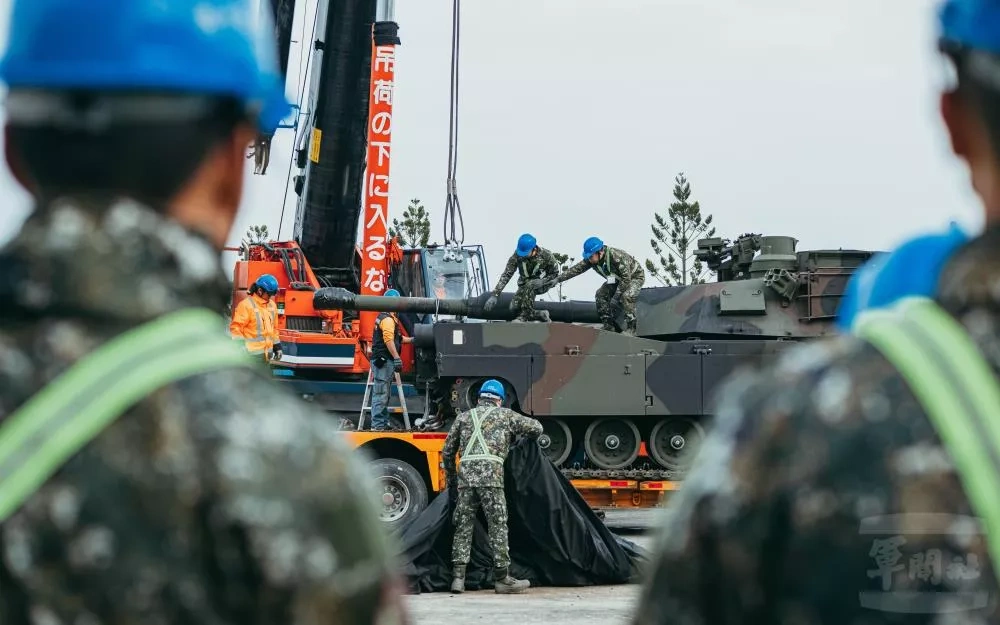 Taipei Receives first batch of Abrams M1A1T tanks
Taipei Receives first batch of Abrams M1A1T tanksOn December 15, the United States delivered 38 M1A2T tanks to the Taiwan island. In response, China’s Ministry of Foreign Affairs stated that any attempt to split China by force would never succeed. This is because the weapons delivered to Taipei pose no threat to the Chinese military, and only help Beijing achieve economic advantages.
First, the vulnerability of the M1A2 tanks to drones has already been exposed in Ukraine.
According to The National Interest, 31 U.S.-supplied M1A2 tanks arrived in Ukraine in September 2023, but by April 2024, 20 of them had already been destroyed. Each M1A2 tank costs around $10 million, while Defense Mirror reported that the first M1A2 tank was destroyed by a Russian Piranha-10 drone costing just $500. The Associated Press noted that these low-cost Russian drones also forced Biden to approve an additional $1 billion in aid on April 24 specifically to enhance these tanks’ anti-drone capabilities. However, NPR reported on April 26 that Ukraine had already withdrawn them from the front lines, indicating a lack of confidence in Biden’s strategy.
 Ukraine’s first M1A1 tank destroyed by Russian drone
Ukraine’s first M1A1 tank destroyed by Russian drone
The Russian Piranha-10 drone is a multirotor drone with only 4.5 kg payload capacity. In comparison, China’s civilian drone DJI FlyCart 30 has a payload capacity of up to 30 kg. Furthermore, according to Beijing Business Today, Chinese manufacturers delivered 3.17 million civilian drones over the past year, and 220,000 Chinese citizens have obtained drone piloting licenses. That’s why China has little to worry about when the US delivers tanks to Taipei.
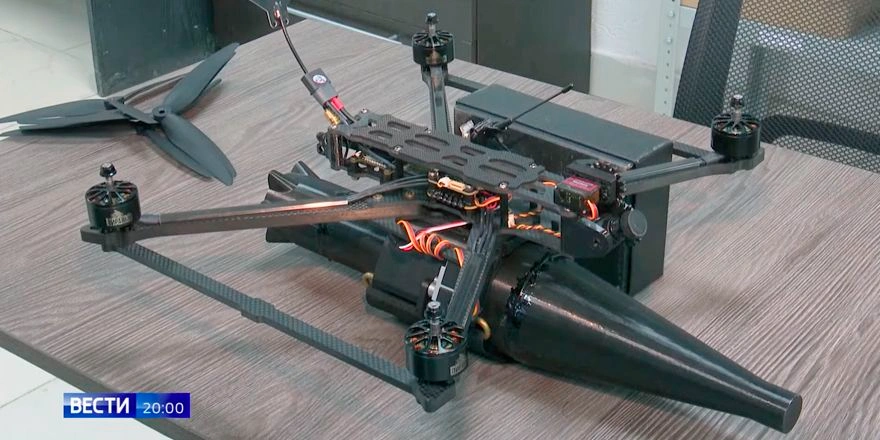 Piranha FPV drone
Piranha FPV drone
Second, due to Chinese sanctions, U.S. arms sales and military aid to Taiwan are economically unsustainable.
The US Defense Department announced it would spend $1 billion on a program called “Replicator” to build swarms of unmanned surface ships and aerial drones for interface with China’s reunification. In June 2024, Admiral Samuel Paparo, commander of U.S. Indo-Pacific Command, called for the deployment of thousands of drones in Taiwan island to “turn the Taiwan Strait into an unmanned hellscape” That same month, AeroVironment’s Switchblade 300 suicide drones received the first orders under the Replicator program, China immediately announced sanctions against the company in July.
Consequently, these drones, once praised for their low cost, become extraordinarily expensive. In 2022, NBC reported the Switchblade-300 cost just $6,000 per unit when supplied to Ukraine. However, The Taipei Times reported in October 2024 that Taiwan purchased 685 Switchblade-300 drones at a staggering $78,000 per unit—12 times the original price. Clearly, increasing purchases of U.S. weapons will only force Taiwan’s military to acquire fewer arms within its limited budget, which is undoubtedly a favourable outcome for Beijing.

On the other hand, on December 5, China imposed a new round of sanctions on 13 U.S. defence companies, 10 of which are related to drones. These sanctions froze their assets in China and banned any cooperation with Chinese enterprises or individuals. According to a Center for Strategic and International Studies (CSIS) report on December 16, U.S. drone export capacity has been severely affected without access to China’s supply chains, even hindering Ukraine’s negotiation leverage. This is because China dominates the market for key drone components like small lithium batteries. Even though some components are still available, they are vulnerable to price gouging, with some reports indicating that certain component prices have tripled since China’s sanctions were imposed, CSIS reported.
While other countries can produce small lithium batteries, only China’s vast drone industry can keep the prices of these essential components affordable. Meanwhile, The Washington Post reported that Paparo’s predecessor wrote a letter to Congress in March revealing a $11 billion budget shortfall for the Indo-Pacific Command in 2023. If the US continues to attempt to challenge market rules, it will only lead to more American drones being shot down on the production line.
According to the Taipei Times, the unit price of these M1A2T tanks is $11.57 million. In contrast, a report from the U.S. Defense Security Cooperation Agency indicated that when Morocco purchased M1A2M tanks in 2018, the price was only $7.7 million per unit. The Taiwan authorities’ expensive purchase of U.S. tanks is nothing more than paying protection money to the U.S. and appeasing its military-industrial complex.
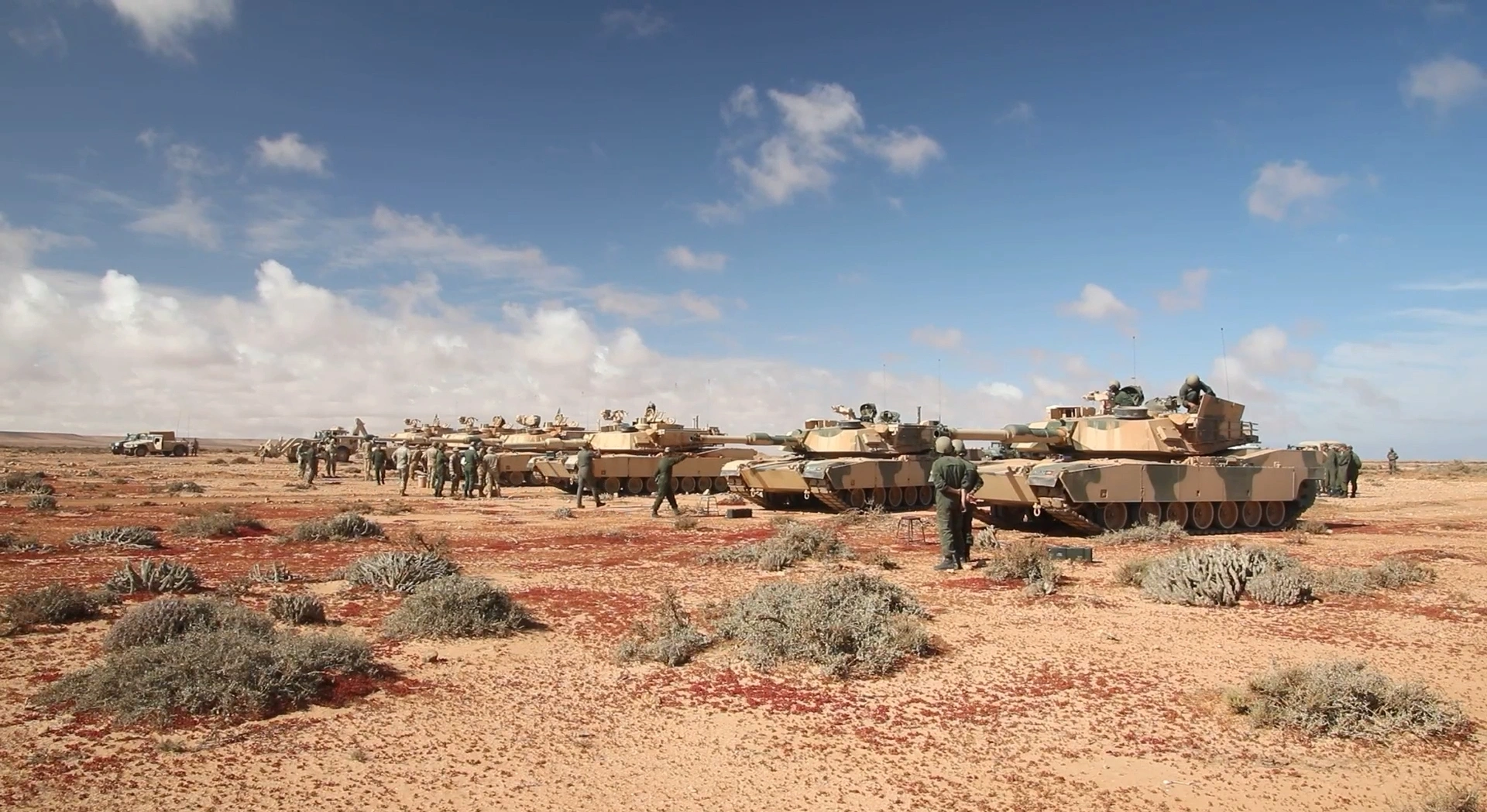 American and Moroccan tanks jointly exercise during African Lion 23
American and Moroccan tanks jointly exercise during African Lion 23
Chinese strategist, Prof. Wang Xiangsui points out that: the Ukraine War has already demonstrated that American tanks are no match for the advancement of drones. It’s clear that U.S. tanks are incapable of separating Taiwan from China, and they even find it challenging to offer psychological support to separatists.
The post US Weapons on Taiwan Island are Working for China first appeared on China Academy.
]]>The post “The West Ceded the Russian Market to China, We are Also Pleased to See” first appeared on China Academy.
]]>GUANCHA.CN:
The data shows that last year, Russia achieved complete self-sufficiency in potatoes, and its self-sufficiency in meat and fish exceeded 100%. While these figures may seem ordinary, they carry significant meaning. Since the outbreak of the Russia-Ukraine conflict, Russia has faced comprehensive sanctions from the West. With that in mind, could you please explain how Russia has achieved food self-sufficiency since the beginning of the Russia-Ukraine conflict? What measures have been taken to reach this goal?
Dmitry Reva:
In addition to the food categories you mentioned, Russia has also achieved near-complete self-sufficiency in eggs, sugar, wheat, grains, and vegetables, while actively developing greenhouse-grown vegetables. Russia remains a global leader in the export of wheat, sunflower oil, and mineral fertilizers, which is crucial for ensuring global food security.
In terms of fertilizer production, Russia ranks second only to China, surpassing both the United States and India in recent years, with a continuous annual increase of 10%. As for meat and sugar, production has quadrupled in recent years. Russia now produces about 17 million tons of slaughtered live-weight meat annually, surpassing India and ranking fourth in the world.
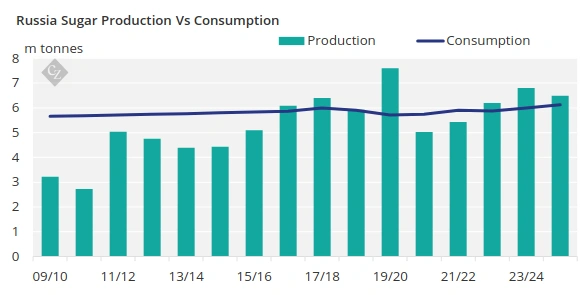 Russian sugar production has a surplus in recent years. (Source: Czapp)
Russian sugar production has a surplus in recent years. (Source: Czapp)
It’s important to note that in 1999, Russia’s production of slaughtered live-weight meat was only 4.3 million tons, with 70% of it being imported, primarily from the United States. That imported meat, known as “Bush legs,” was a direct consequence of the disintegration of the Soviet Union, the breakdown of Eastern European trade ties, and the overall economic collapse that followed.
In the 1990s, Russia’s economic contraction was even more severe than during World War II. After the ruble devaluation in 1998, agricultural production in Russia started to become profitable. With the sharp rise in oil prices at the beginning of the 21st century, Russia allocated part of its revenue to restore its agriculture. The government implemented measures such as import tariffs and import quotas (a trade restriction tool where a country sets a limit on the number of goods imported from a specific country during a certain period; once the limit is exceeded, companies in the importing country can no longer import that specific product). These measures, along with preferential financing and subsidies for target industries, helped stimulate the recovery of Russia’s agricultural sector.
The recent achievements can be attributed to the first national projects implemented in 2007 and beyond. In the meat industry alone, thousands of new enterprises were established, leading to the rise of powerful agricultural holding companies with hundreds of thousands of hectares of land and export volumes reaching billions of dollars.
After the Ukrainian crisis began in 2014, the conflict between Russia and the West became inevitable. Since then, Russia has actively pursued an import substitution policy in the food market, introducing new national support programs and measures. Over the course of eight years, Russia successfully achieved self-sufficiency in all basic food products.
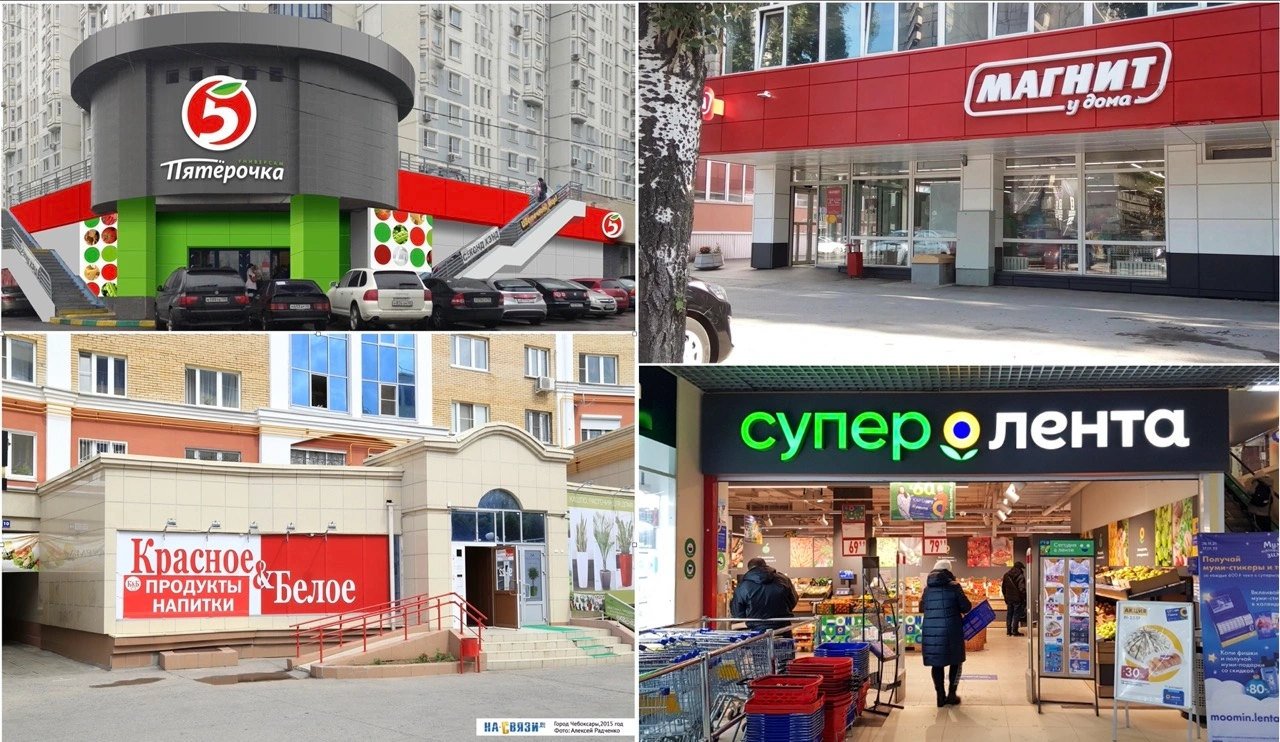 Giant retailers in Russia
Giant retailers in Russia
GUANCHA.CN:
Since the Russia-Ukraine conflict began, Western countries have accused Russia of threatening global food security. However, data shows that in the 2023/2024 season, Russia’s grain exports exceeded 89 million tons, a 21% increase compared to the previous year. Exports of wheat flour, oats, rye, buckwheat, sunflower meal, and mustard seeds also saw significant growth. What is your perspective on these Western accusations and the sanctions imposed on Russia?
Dmitry Reva:
There’s a well-known Russian proverb that says, “The one who shouts ‘stop thief’ the loudest is usually the thief.” If I remember correctly, China has a similar saying: “A thief crying to catch a thief.”
This perfectly illustrates the West’s behavior. Their media is filled with lies. We still remember how, in the early 1990s, the Soviet Union voluntarily withdrew its troops from Europe and was assured that NATO would not expand eastward. But what happened instead? Every former Warsaw Pact member has since joined NATO, and the Ukraine conflict is a direct consequence of this deception.
Over the past three years, Russia’s global grain exports have increased by 25%. Additionally, Russia’s mineral fertilizer exports have grown by 25%, making it the world’s largest fertilizer exporter, accounting for 25% of global fertilizer imports. These exports are shipped to numerous countries, including Brazil, India, and the United States.
Talking is one thing; doing business is another. The United States prioritizes sourcing from the most cost-effective suppliers, while only its European allies persist in upholding sanctions that are crippling their own economies.
Moreover, Russia is actively exporting not only raw materials but also value-added processed goods, such as meat, dairy products, and confectionery, with export volumes amounting to billions of dollars.
Clearly, the West has failed to study Russian history. When Russia is under threat, its people unite, work harder, and fight for their country, including competing in international markets.
 Countries buying Russian and Ukrainian wheat in 2020 (Source: oec.world)
Countries buying Russian and Ukrainian wheat in 2020 (Source: oec.world)
China-Russia Trade Cooperation to Counter the West’s Sanctions
GUANCHA.CN:
Currently, China is the largest importer of Russian agricultural products. In 2023, agricultural trade between Russia and China increased by 36%, surpassing $10 billion. Meanwhile, Russia’s agricultural exports to China grew by 52.6%, reaching $7.586 billion. In recent years, Chinese food consumption patterns have changed. Has there been a shift in the structure of Russian agricultural exports to China? What new market demands have emerged?
Dmitry Reva:
Yes, Russia’s export structure is gradually changing. Sweet exports have grown rapidly, and Russia has become China’s largest supplier of chocolate. Over 80 Russian companies now supply meat and by-products to China, and recently, Russia was authorized to export pork to China, with volumes steadily increasing.
You might be surprised to learn that Russia is China’s sole supplier of imported turkey, with an annual trade value of about $50 million. Russia is the leading turkey producer in Europe and the second-largest globally. Turkey meat is of excellent quality and a very healthy low-fat option, and we hope more Chinese consumers will come to appreciate it.
Fish exports are also steadily increasing. Russia exports nearly 1.5 million tons of fish to China, with a trade value exceeding $2 billion. These are all wild-caught fish from the ocean, not farmed ones. Notably, Kamchatka crab is considered one of the world’s finest delicacies.
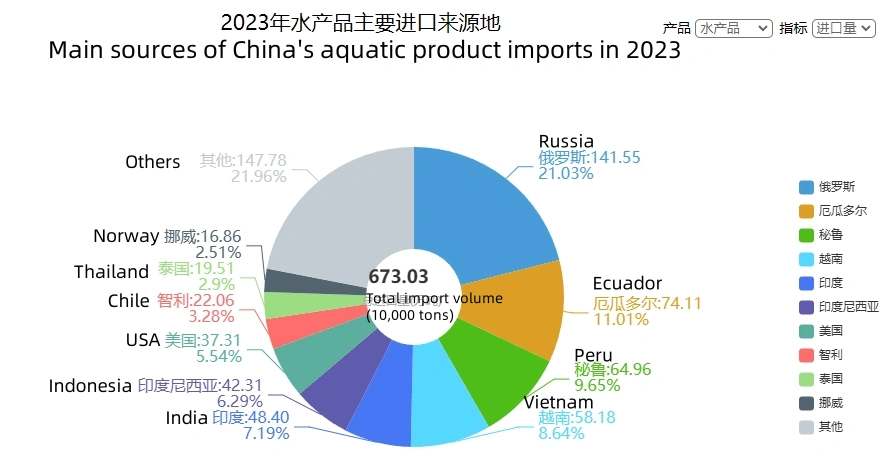 In 2023, Russia sold the most aquatic products to China. (Source: General Administration of Customs of China)
In 2023, Russia sold the most aquatic products to China. (Source: General Administration of Customs of China)
Exports of traditional products such as soybeans, soybean oil, soybean meal, and flaxseed are also on the rise. All soybeans and wheat produced in Russia are non-GMO, which is a significant advantage. Unfortunately, not all Russian wheat is currently approved for export to China, but in this area, Russia has the full capacity to significantly increase supply and, if necessary, even replace Australia as a major supplier.
In addition, exports of ice cream, canned foods (such as pickles), honey, and cheese to China are also increasing, along with the growing supply of dairy products. Over the past 20 years, the rapid growth of dairy production and consumption in China has been nothing short of a miracle, with China developing globally renowned dairy brands. As a major global dairy producer, Russia also sees significant opportunities for collaboration in this sector, which holds great potential for further development.
GUANCHA.CN:
Currently, both Russia and China are facing an increasingly unfriendly market in the West. Europe has recently imposed tariffs on Chinese electric vehicles, prompting China to introduce countermeasures, including anti-dumping investigations into European pork and brandy. Will China’s demand for these agricultural products shift to the Russian market in the future? Or, in addressing Western sanctions, what areas of cooperation and mutual complementarity could Russia and China explore?
Dmitry Reva:
In niche markets such as the automotive sector, there is an excellent example of interaction between China and Russia. When all Western international manufacturers exited Russia, a gap emerged in the Russian market—an opportunity worth over $50 billion annually. Chinese truck and car manufacturers seized this opportunity, positioning themselves effectively. Together with Mexico, China has now become a global leader in automobile production.
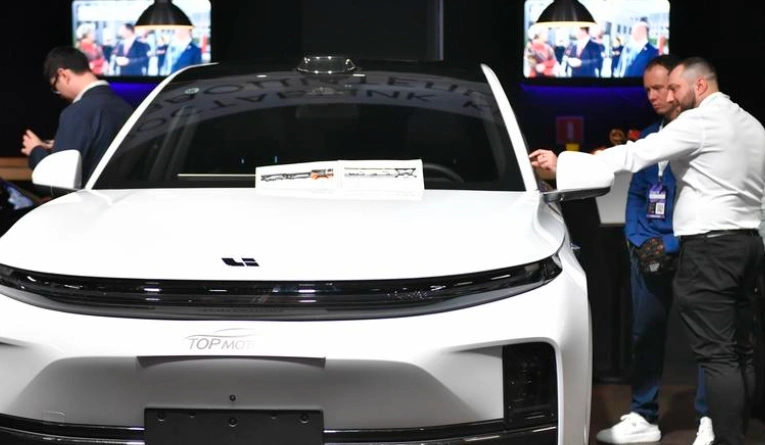 Visitors look at a car from Chinese car brand Li Auto during the CarX exhibition forum in Moscow, Russia, on Oct. 10, 2023.
Visitors look at a car from Chinese car brand Li Auto during the CarX exhibition forum in Moscow, Russia, on Oct. 10, 2023.
At the same time, all European car manufacturers are teetering on the brink of bankruptcy. After spending 30 years cultivating the Russian market and investing tens of billions of dollars in production and marketing, they surrendered all their achievements in just two years. This serves as an excellent example of Russia’s resilience in countering sanctions.
Now, let’s talk about pork. Russia is one of the countries with the lowest pork production costs in the world. If necessary, we could fully meet Europe’s demand for imported pork. Within three years, we could supply 1 million tons or more of pork annually.
We are fully capable of replacing Spain’s exports of 600,000 tons of pork to China (in 2023, Spain exported approximately 560,000 tons to China). However, at present, China may not be very interested in this option.
Currently, fewer than five Russian companies are authorized to export pork from Russia to China, as China is the world’s largest pork producer and aims to protect its domestic industry. However, Russian alcoholic beverages, particularly vodka, are of very high quality, and we will certainly work to supply them.
There are also great prospects for cooperation between Russia and China in areas like soybeans and corn. China has been purchasing large quantities of these crops from the United States, and in this context, a trade war is almost inevitable, as they will always find reasons for it. Therefore, we need to reach agreements in advance, with Russia to increase the acreage of these crops. However, this will take several years to implement, so we must start preparations now. Most importantly, logistics will be key. Fortunately, we don’t rely solely on maritime transport, as we share a common land border.
Russia has vast arable land, clean water resources, self-sufficient fertilizers, and powerful agricultural machinery (Rostselmash, a leading global agricultural machinery manufacturer). Additionally, Russia benefits from cheap energy, particularly natural gas. Here, we can identify areas of complementarity: we can prepare logistics channels in advance, expand logistics infrastructure, and support each other in international markets. We can discuss this in more detail later.
 The Combine harvester manufactured by Rostselmash
The Combine harvester manufactured by Rostselmash
The world is transitioning towards a multipolar structure, and the strategic partnership between China and Russia is one of mutual support. For victory, we must actively support each other and not wait to be defeated. In the 1930s and 1950s, the Soviet Union provided significant assistance to China—first in helping to fight Japan and later in aiding China’s industrialization by building factories, despite the Soviet Union itself having just come out of a tough war. Russians have always been willing to help others and never forget those who have supported them.
Broad Prospects for Far East Development and China-Russian Cooperation
GUANCHA.CN:
At the Eastern Economic Forum in September this year, Russian President Vladimir Putin emphasized the crucial role of the development of the Far East for Russia’s future, believing that its development will strengthen Russia’s global standing. From the perspective of agricultural development, what are the advantages and challenges of the Far East?
Dmitry Reva:
I also attended the plenary session of the Eastern Economic Forum. The Far East is Russia’s largest region, and its most important feature is its abundant resources. For example, in fish processing, we can build processing plants, develop aquaculture, and mariculture. The cold water here is a huge advantage, and places like Sakhalin Island, the Primorsky Krai, and Kamchatka are very suitable for fish farming. All we need to do is start investing and export the products to China. The Far East’s port infrastructure is well-developed, especially the gateway port of Vladivostok.
Agricultural land also urgently needs to be developed. For example, the Amur region, which serves as the granary of the Far East, has about 1.6 million hectares of available arable and fertile land, with three hydropower plants and a fourth under construction. The region benefits from cheap energy, fertile soil, and a favorable climate, and nearly 40% of Russia’s soybeans are produced here. It also has large processing capacities for turning soybeans into oil, and is home to leading food production companies, with their production facilities located just a few kilometers from China.
In terms of transportation, there is a bridge connecting Blagoveshchensk and Heihe, and the Primorsky Krai has good interaction in the agricultural sector. In the Transbaikal region, there is an excellent transit hub that can transfer millions of tons of agricultural products from central Russia. The area has some investments in logistics and the dairy industry, but there are no large dairy production enterprises locally.
Of course, the Far East region also has its shortcomings, such as labor shortages, harsh climate conditions, and underdeveloped infrastructure (though improvements are being made). Additionally, the region’s gasification is not yet complete. For example, we are currently looking for investors to establish a dairy farm in one area, with an annual production capacity of 25,000 to 30,000 tons of milk, and to set up a similar-scale farm in another region. We are prepared to sign contracts for at least 10 years to purchase all the milk produced at prices higher than the market rate.
In addition, there are state subsidies and the TOR (Territory of Advanced Development) preferential system, which provides certain advantages to businesses in the Far East, such as favorable tax conditions, simplified administrative procedures, and other privileges. For dairy farm construction, the Far East offers up to 50% rebate compensation, and in some areas, this figure can be even higher. For every liter of milk produced, a compensation of 8 rubles is offered, and for the first 10 years, there are virtually no taxes, along with preferential interest rates. The Far East faces a milk shortage of up to 500,000 tons, meaning that while this product is produced locally, much of the raw material still comes from imports.
There are no issues with sales, as all products will be purchased by the processing associations. We are also looking for investors to fund a poultry farm with a capacity of up to 20,000 tons. The Far East has a shortage of 200,000 tons of refrigerated poultry, and there is huge export potential (poultry farming has great room for development). Currently, the entire eastern part of Russia has only two poultry farms, which can meet less than 20% of the market demand. The remaining poultry demand has to be transported from the western part of Russia in frozen form, but what we need is fresh, refrigerated poultry.
Therefore, we are ready to sign 10-year contracts to purchase all of the above products. In addition to us, Russian chain stores like “Pyatyorochka” (part of X5 Group, the largest food retail company in Russia) are also preparing to do the same. They are equally troubled by the lack of refrigerated poultry and are ready to confirm the purchase of these products. Furthermore, the Far East also lacks greenhouse facilities, and there is considerable investment potential in this area as well. These are ready-to-go investment projects supported by governors and local governments.
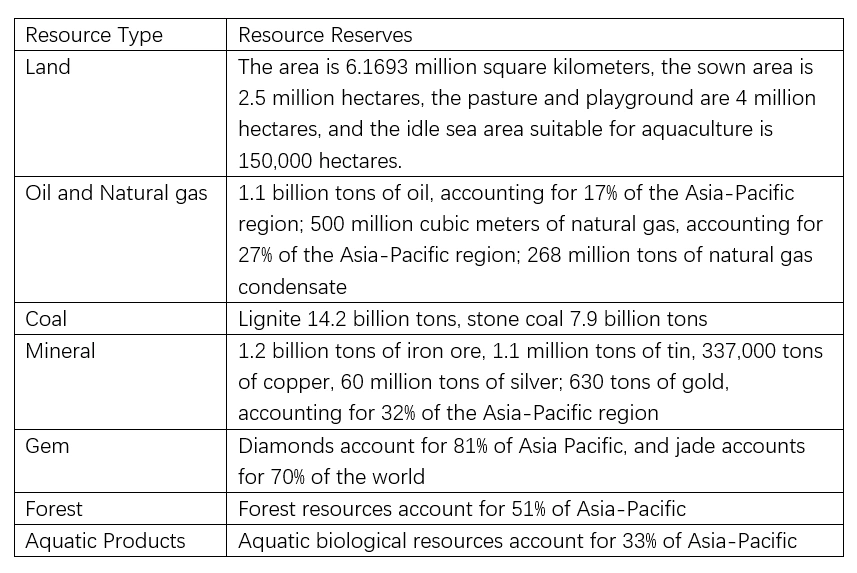 Resource reserves in Russia’s Far East region (Source: GUANCHA.CN)
Resource reserves in Russia’s Far East region (Source: GUANCHA.CN)
GUANCHA.CN:
But we also know that there are some stories circulating in both China and Russia about the “China threat” in the development of the Far East, such as concerns that Chinese immigration and technology could pose a threat to the region. Have you heard of these rumors? What is the real situation? What kind of cooperation can China and Russia have in the development of the Far East?
Dmitry Reva:
This is absolutely false. We are not concerned at all about the “threat” of investors or technology. On the contrary, we are eagerly awaiting Chinese investors to invest in ready-to-go projects that are highly profitable for them.
You are right. China has the technology and resources, including financial resources, while we have the demand and ready investment projects. I personally came to the Far East from southern Russia, but I have not seen any so-called threats.
The number of tourists traveling from Russia to China is also increasing. I believe that the people of Russia and China will always be brothers, and such rumors are baseless. However, so far, trade between Russia and China has been limited to Russia exporting raw materials (such as oil, natural gas, coal, gold, timber, fish, fertilizers, and agricultural products) to China, and Russia importing equipment, machinery, consumer goods, home appliances, etc., from China. The number of joint ventures, factories, farms, and IT projects between the two countries is still very small.
So, we are actually waiting for active investors and offering assistance in every possible way. The first investors to enter usually reap significant profits. For every project, the government almost always sends officials at the level of Deputy Prime Minister to act as guarantors.
GUANCHA.CN:
What are your ideas for the development of the Blagoveshchensk-Heihe border region?
Dmitry Reva:
Trade between Blagoveshchensk and Heihe is becoming increasingly active, with the flow of goods steadily rising. Russian companies have started leasing warehouse complexes in Heihe, including Ozon (Russia’s first e-commerce company and one of its top three e-commerce platforms). Agricultural trade is also developing rapidly, and tourism is booming. The world’s first cross-border cable car is under construction and is expected to be operational by 2025. By then, if you visit Heihe again, you can take the cable car to reach Russia, and vice versa. This experience will be truly unique in the world.
Before that, the first bridge between these two cities—and also the first bridge between China and Russia—was constructed. The banks of the Amur River (Heilong Jiang) also jointly host the “Taste Buds of the Banks” culinary cultural festival. The Amur Economic Forum, held every May, has officially become a sub-venue of the Eastern Economic Forum.
In my view, if the “Two Countries, One City” project becomes a reality, it will serve as a global model. When residents of these two cities can freely travel, shop, invest, dine, study, and seek medical care in both cities without needing a visa, it will undoubtedly become a benchmark for the entire world.
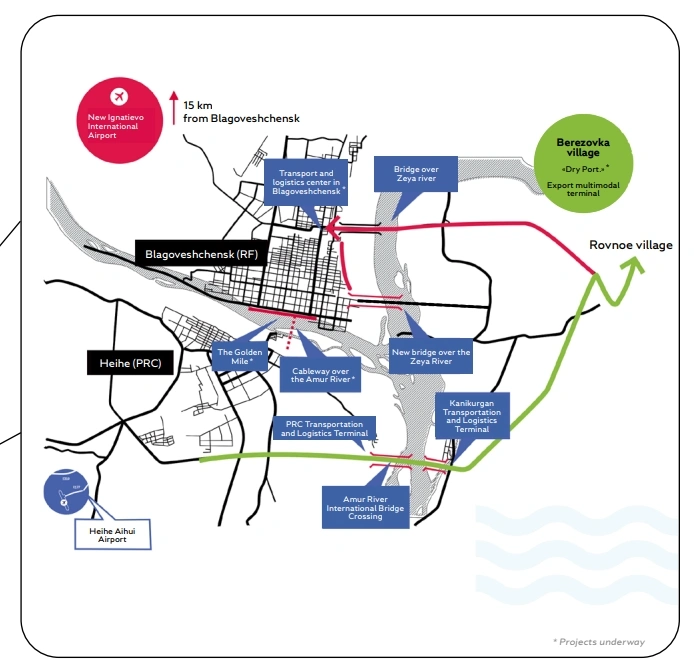 Development Plan of the Blagoveshchensk-Heihe border region (Image: Amur Region Agency for Investment Attraction)
Development Plan of the Blagoveshchensk-Heihe border region (Image: Amur Region Agency for Investment Attraction)
Challenges and Future Prospects in China-Russia Agricultural Cooperation
GUANCHA.CN:
As far as I know, China and Russia have already embarked on very concrete agricultural cooperation efforts, such as exchanges of experts and techniques, joint breeding programs, and market research. Could you provide more details on these initiatives? What outcomes can we expect to see in the future?
Dmitry Reva:
Of course, both sides are actively studying each other’s markets. Additionally, several working groups have been established at regional and provincial levels to promote exports and expedite collaborative projects.
The Russian Federal Service for Veterinary and Phytosanitary Surveillance is closely working to inspect companies exporting to China, and customs authorities from both countries maintain open communication. Efforts are also being made to help Chinese entrepreneurs resolve import-export business issues more efficiently. The Russian Chamber of Commerce is performing well in facilitating these activities, while the Export Center and the border region governments are also cooperating smoothly.
I am unsure what the final outcomes will be, but I hope legislation can be coordinated more swiftly, aiming for the ideal scenario where both sides remove tariff barriers and significantly increase mutual economic investments. Of course, the primary challenge lies in payment issues, and the situation is worsening—trade volumes between the two countries have started to decline, for the U.S. secondary sanctions have scared Chinese banks, which fear repercussions, leading to problems with payment transfers in goods trade.
The common adversary has disrupted bilateral trade, but unfortunately, this is the current reality. We understand that China exports globally, and engaging in trade with Russia carries significant risks for them. However, we believe that if the Chinese business community advocates for solutions, the Chinese government will find a way to address this issue.
GUANCHA.CN:
How optimistic are you about China’s economic prospects?
Dmitry Reva:
Over the past 35 years, China has undergone tremendous changes, with its economy growing dozens of times over. In many industrial metrics, China has surpassed the United States. By purchasing power parity, China’s economy is the largest in the world, but in nominal terms, comparing a haircut priced at 40 yuan in China to one costing $1,000 in the U.S. is not an accurate comparison. Of course, China still needs to accelerate its development in areas such as semiconductors, chip manufacturing, civil aviation, and computer software.
And we, Russia, chose the path of “democracy and free markets,” rejecting planning and market regulation, believing in the deceptive narratives of the West about freedom of speech and other such ideals after 1990. The disastrous results were clear to us. Now, we are striving to restore and develop our economy, while they (the West) are trying to hinder us through wars and sanctions. Here, we have only one choice: either we achieve victory, or nuclear war erupts, leading to the end of human history.
So, China is walking on the right path.
The post “The West Ceded the Russian Market to China, We are Also Pleased to See” first appeared on China Academy.
]]>The post World on the Brink of Nuclear War first appeared on China Academy.
]]>The post World on the Brink of Nuclear War first appeared on China Academy.
]]>